Pre-Architectures
Curators: Silvia Franceschini, Nikolaus Hirsch & Spyros Papapetros.
November 6, 2024 – March 30, 2025
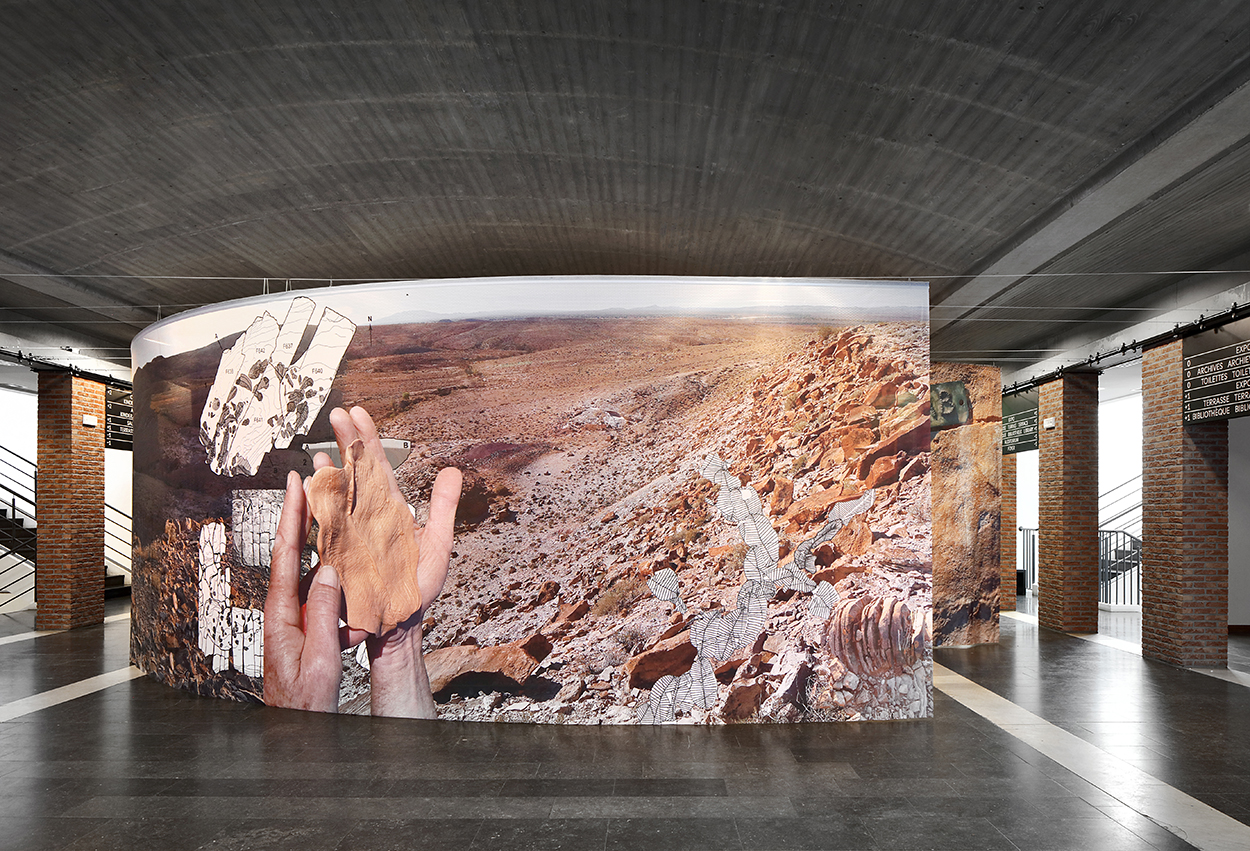
Installation view of “Mariana Castillo Deball: Once I thought the world was somewhere else”
CIVA Brussels, November 6, 2024 – March 30, 2025.
Curators: Silvia Franceschini, Nikolaus Hirsch & Spyros Papapetros.
Made possible with the support of Instituto Guimarães RosaEmbassy of Brazil in Brussels Austrian Frederick and Lillian Kiesler Private Foundation.
Photograph courtesy of CIVA © Filip Dujardin.
Once I thought the world was somewhere else presents a textile diorama, which overlaps translucent fabrics with color photographs printed on fabric. The textiles are perforated with large organic shapes and reworked with appliqués of semitransparent mate-rials. In 2018, the artist visited the Ediacara Hills in Australia with staff from the South Australian Museum for research and training. The artist drew inspiration from the landscape and fossils of this landscape, as well as from the illustrations of Peter Trusler, a scientist and artist who collaborates closely with researchers to visualize Ediacaran life. Predating the diverse fauna of the Cambrian Era, the Ediacaran organisms are believed to have been the earliest forms of complex life on Earth and are characterized by their soft bodies. Despite having been studied for decades at various sites around the world, they maintain a sense of mystery for scientists, who struggle to recognize in them the clear ancestors of modern animal life. The installation, which is part of the project "Replaying Life's Tape", refers to an experiment by evolutionary theorist Stephen Jay Gould, which proposed that if we could rewind the tape of life and start again, we would get a different result each time - and that the evolution of humanity would be quite unlikely.
The installation rewinds the tape right back to the beginning of life on Earth.
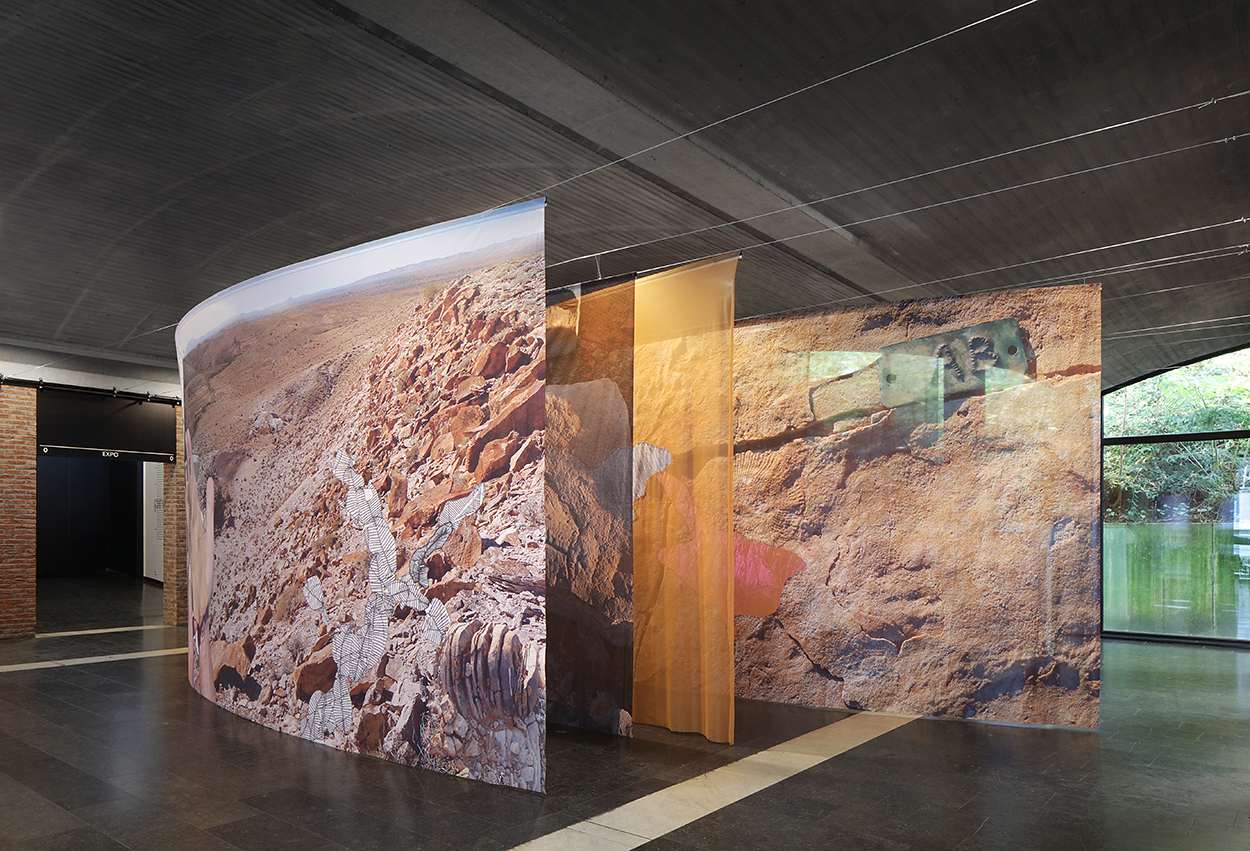
Installation view of “Mariana Castillo Deball: Once I thought the world was somewhere else”
CIVA Brussels, November 6, 2024 – March 30, 2025.
Curators: Silvia Franceschini, Nikolaus Hirsch & Spyros Papapetros.
Made possible with the support of Instituto Guimarães RosaEmbassy of Brazil in Brussels Austrian Frederick and Lillian Kiesler Private Foundation.
Photograph courtesy of CIVA © Filip Dujardin.
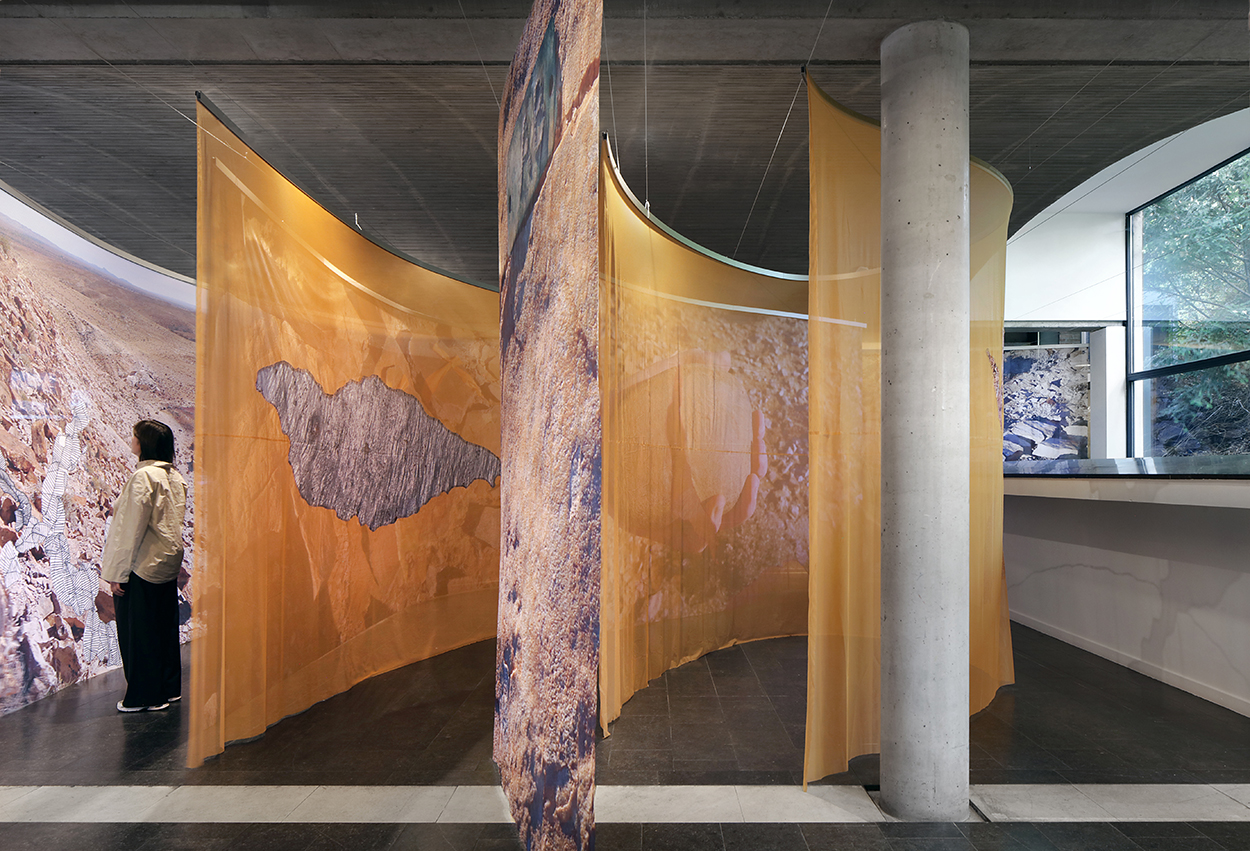
Installation view of “Mariana Castillo Deball: Once I thought the world was somewhere else”
CIVA Brussels, November 6, 2024 – March 30, 2025.
Curators: Silvia Franceschini, Nikolaus Hirsch & Spyros Papapetros.
Made possible with the support of Instituto Guimarães RosaEmbassy of Brazil in Brussels Austrian Frederick and Lillian Kiesler Private Foundation.
Photograph courtesy of CIVA © Filip Dujardin.
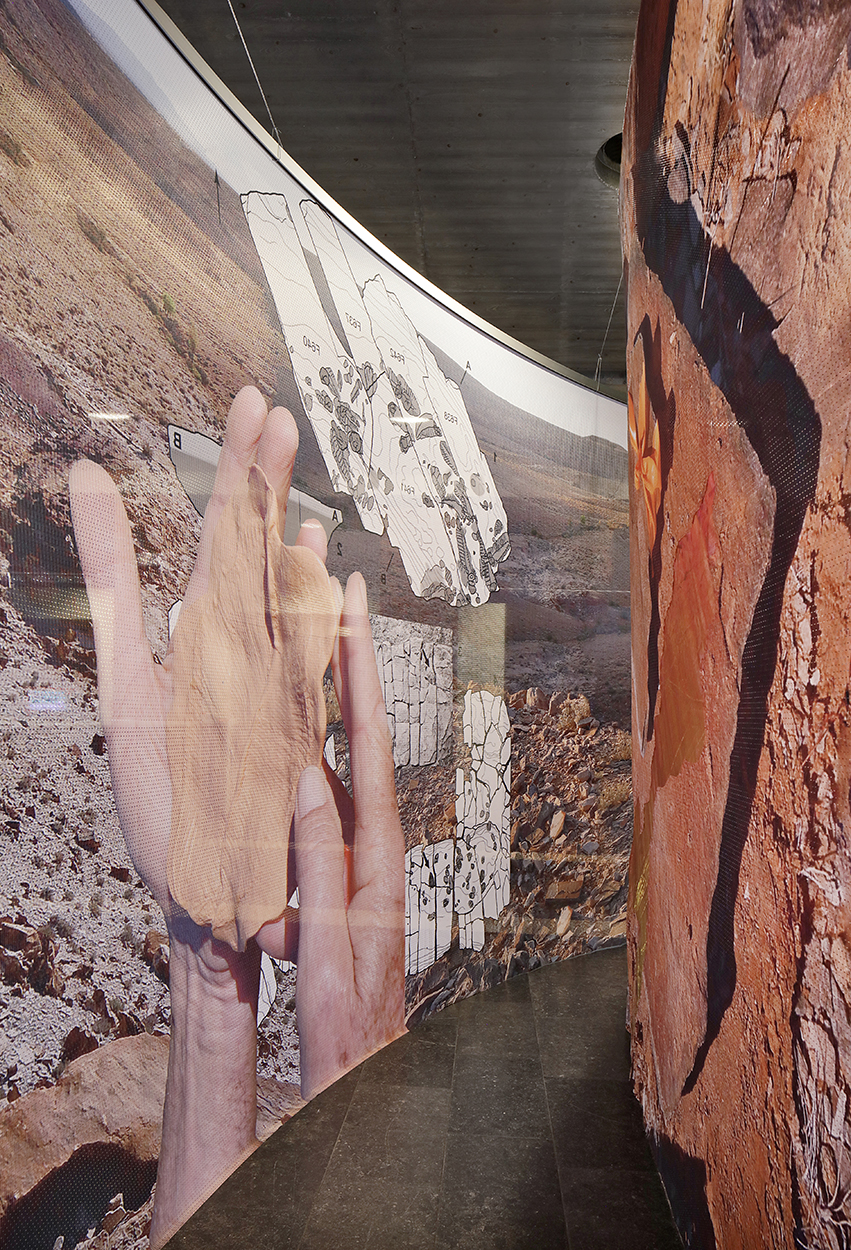
Installation view of “Mariana Castillo Deball: Once I thought the world was somewhere else”
CIVA Brussels, November 6, 2024 – March 30, 2025.
Curators: Silvia Franceschini, Nikolaus Hirsch & Spyros Papapetros.
Made possible with the support of Instituto Guimarães RosaEmbassy of Brazil in Brussels Austrian Frederick and Lillian Kiesler Private Foundation.
Photograph courtesy of CIVA © Filip Dujardin.
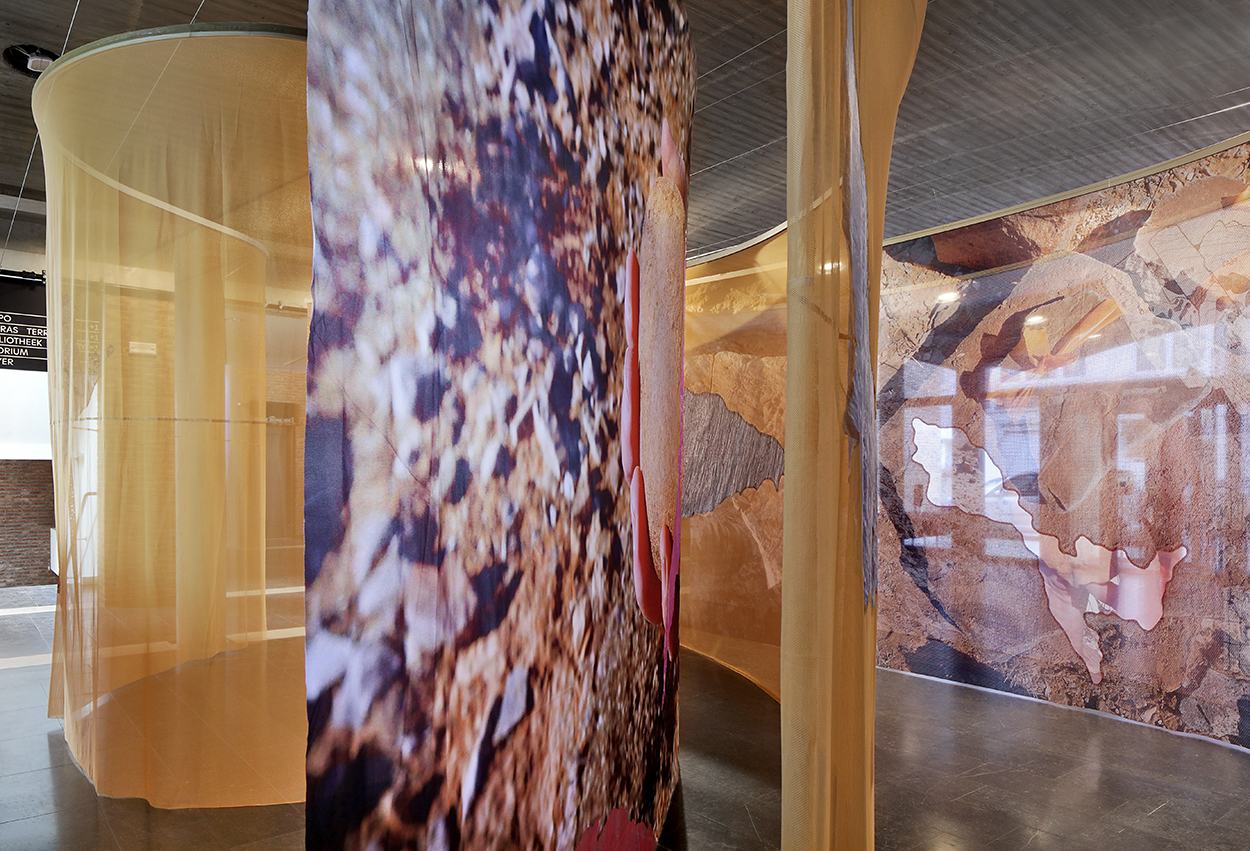
Installation view of “Mariana Castillo Deball: Once I thought the world was somewhere else”
CIVA Brussels, November 6, 2024 – March 30, 2025.
Curators: Silvia Franceschini, Nikolaus Hirsch & Spyros Papapetros.
Made possible with the support of Instituto Guimarães RosaEmbassy of Brazil in Brussels Austrian Frederick and Lillian Kiesler Private Foundation.
Photograph courtesy of CIVA © Filip Dujardin.
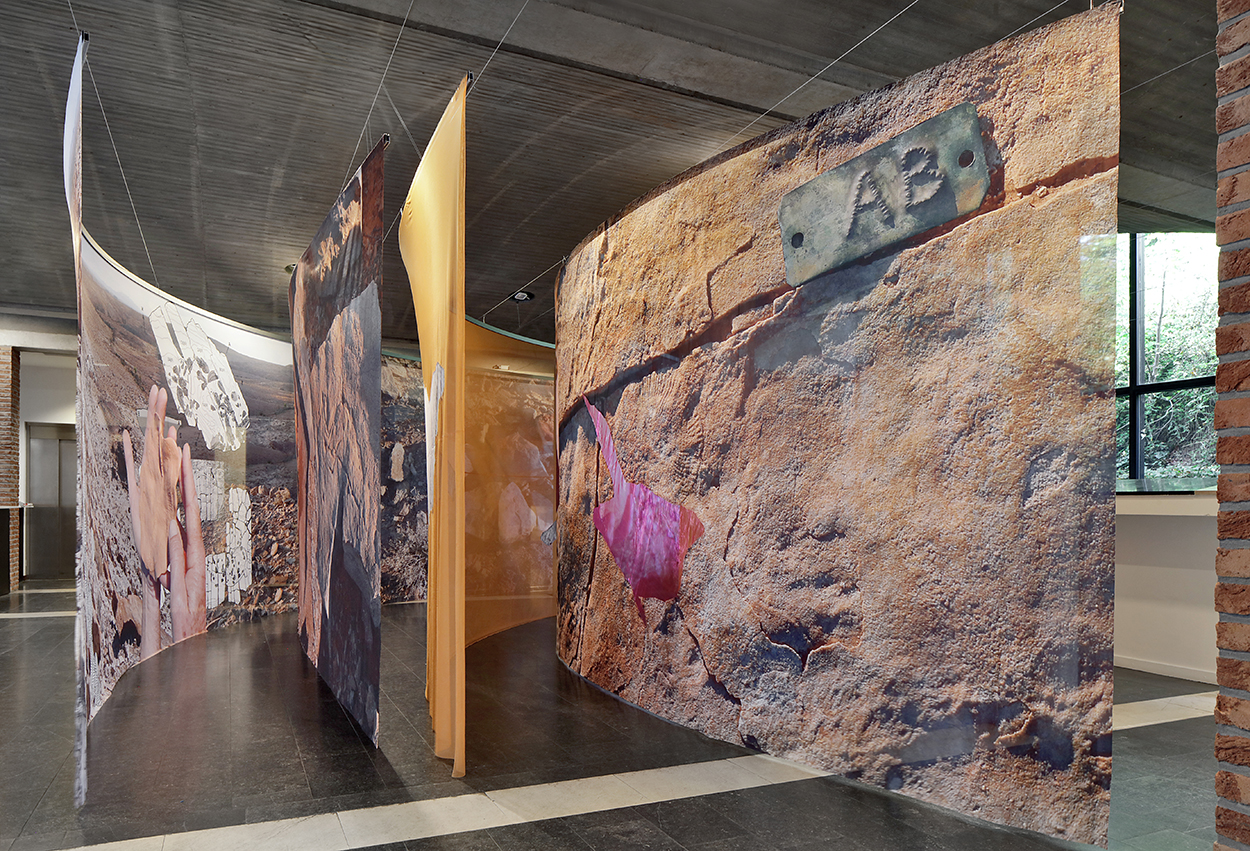
Installation view of “Mariana Castillo Deball: Once I thought the world was somewhere else”
CIVA Brussels, November 6, 2024 – March 30, 2025.
Curators: Silvia Franceschini, Nikolaus Hirsch & Spyros Papapetros.
Made possible with the support of Instituto Guimarães RosaEmbassy of Brazil in Brussels Austrian Frederick and Lillian Kiesler Private Foundation.
Photograph courtesy of CIVA © Filip Dujardin.

Installation view of “Mariana Castillo Deball: Once I thought the world was somewhere else”
CIVA Brussels, November 6, 2024 – March 30, 2025.
Curators: Silvia Franceschini, Nikolaus Hirsch & Spyros Papapetros.
Made possible with the support of Instituto Guimarães RosaEmbassy of Brazil in Brussels Austrian Frederick and Lillian Kiesler Private Foundation.
Photograph courtesy of CIVA © Filip Dujardin.

Installation view of “Mariana Castillo Deball: Once I thought the world was somewhere else”
CIVA Brussels, November 6, 2024 – March 30, 2025.
Curators: Silvia Franceschini, Nikolaus Hirsch & Spyros Papapetros.
Made possible with the support of Instituto Guimarães RosaEmbassy of Brazil in Brussels Austrian Frederick and Lillian Kiesler Private Foundation.
Photograph courtesy of CIVA © Filip Dujardin.
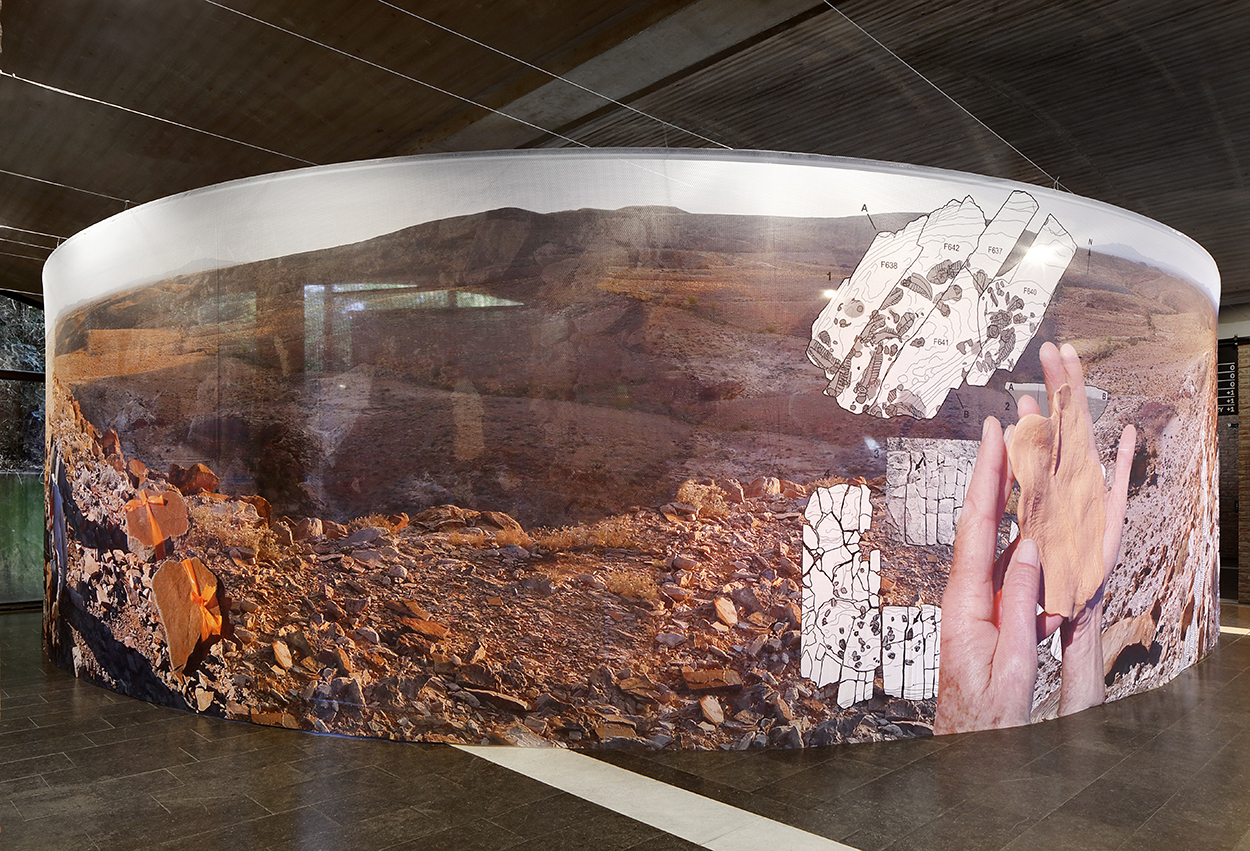
Installation view of “Mariana Castillo Deball: Once I thought the world was somewhere else”
CIVA Brussels, November 6, 2024 – March 30, 2025.
Curators: Silvia Franceschini, Nikolaus Hirsch & Spyros Papapetros.
Made possible with the support of Instituto Guimarães RosaEmbassy of Brazil in Brussels Austrian Frederick and Lillian Kiesler Private Foundation.
Photograph courtesy of CIVA © Filip Dujardin.
REPLAYING
LIFE’S TAPE
Monash University Museum of Art Melbourne Australia October 5 – December 7, 2019 Curated by Hannah Matthews

Production process Replaying Life’s Tape, 2019.
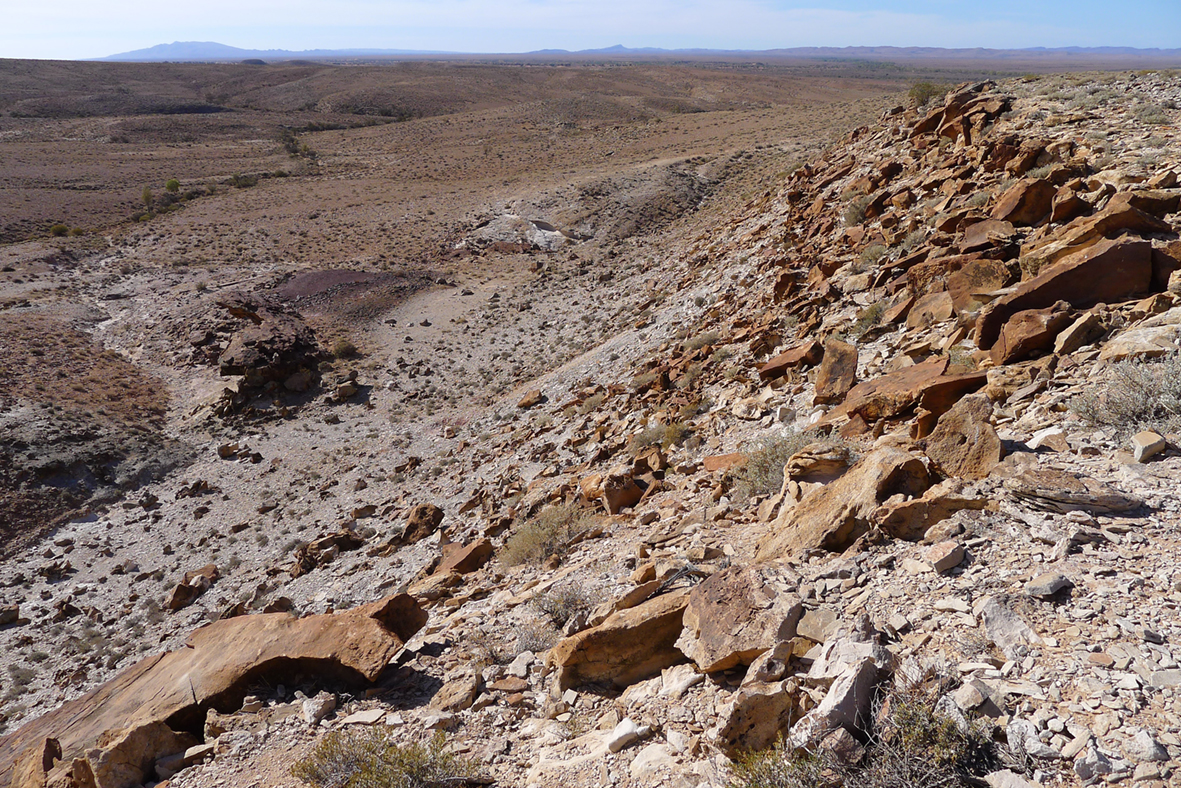
Ediacara fossil site at Nilpena, about 500 km north of Adelaide, South Australia.

Ediacara fossil site at Nilpena, about 500 km north of Adelaide, South Australia. Researchers
study fossil imprints in slabs of sandstone characteristic of this part of the Flinders Ranges.
In May 2018 I travelled to the Ediacara Hills to join a research trip led by Dr Jim Gehling, a Senior Research Scientist with the South Australian Museum who has been studying Ediacara fossils for decades. With his team, we visited fossil sites and got closer to their methods of study and current activities.
The Ediacara Hills region has been known for its abundant fossilised remains since the 1940s, when the Australian geologist Reg Sprigg first discovered imprints in the rocks of the old Ediacara minefield while undertaking mineral exploration. The fossils preserved in the ancient sea floor in today’s Flinders Ranges record the first known multicellular animal life on Earth that predates the Cambrian.
Sprigg’s discovery was ‘the first time the fossilised remains of an entire community of soft-bodied creatures had been found in such abundance anywhere in the world’ 1 and resulted in the naming of the Ediacaran Period (635–541 million years ago). While Ediacara fossil localities have since been discovered in Namibia, Russia, Newfoundland, Canada, United Kingdom and Siberia, the sites in Russia and Australia show the greatest diversity of fossil species. The findings in Australia also debunked a belief among the scientific community that ‘only organisms with hard parts, such as shells or skeletons, could be preserved in the fossil record.’2 Smothered by sand and silt, the soft-bodied organisms of the Ediacaran Period were preserved as mineral ‘death masks’. The fossils are the moulds and casts of their flattened bodies preserved as imprints in siltstone and sandstone layers.
The richest collection of fossils is at Nilpena Station, a privately owned sheep and cattle station that is now partly under the protection of the state government as part of the Ediacara Conservation Park thanks to this heritage. Here, a tennis court–sized area has been surveyed and used for the excavation of fossil-bearing sections of the former sea floor. Whereas previous palaeontological work resulted in the removal of slabs of rock and disturbed the site, current practice is not to remove fossil material, but to invert the stone slabs and leave them for further on-site study.
Replaying Life’s Tape departs from this experience, and the projects I have pursued around palaeontology in recent years. I have drawn inspiration from the landscape and fossils of the Ediacara Hills as well as from the illustrations of scientist and artist Peter Trusler, who has been working closely with scientists and doing his own fieldwork in order to imagine Ediacaran life. The title refers to evolutionary theorist Stephen Jay Gould’s famous thought experiment, which proposed that if we could rewind the tape of life and start again, we would get a different result each time—and humans would be unlikely to evolve. My installation rewinds the tape to the beginning of animal life on Earth.
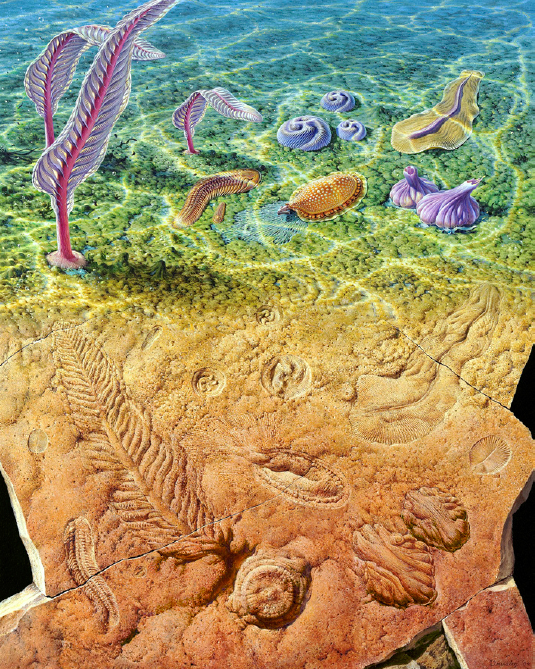
Peter Trusler’s Creatures of the
Slime, 2004,
originally commissioned
by Australia Post for a series of special issue stamps featuring six
life forms from the Ediacara area.
The top section of the image—a
reconstruction of the underwater environment 570 to 540 million
years ago—transitions to a montage of fossilised impressions in the lower section of the image.

Ediacara fossil site at Nilpena, about 500 km north of Adelaide, South Australia.
The Ediacaran are a curious group of multi-cellular organisms understood to be the first forms of complex life on Earth, predating the burgeoning and diverse life of the Cambrian age and distinguishable by their soft bodies. Despite having been studied for decades in various sites around the world, they reserve a sense of mystery for scientists, not being easily recognised as ancestors of animal life today. It is this mystery, the methodology of the scientific community, and their relentless effort to know, file and categorise, that are at the center of the installation.
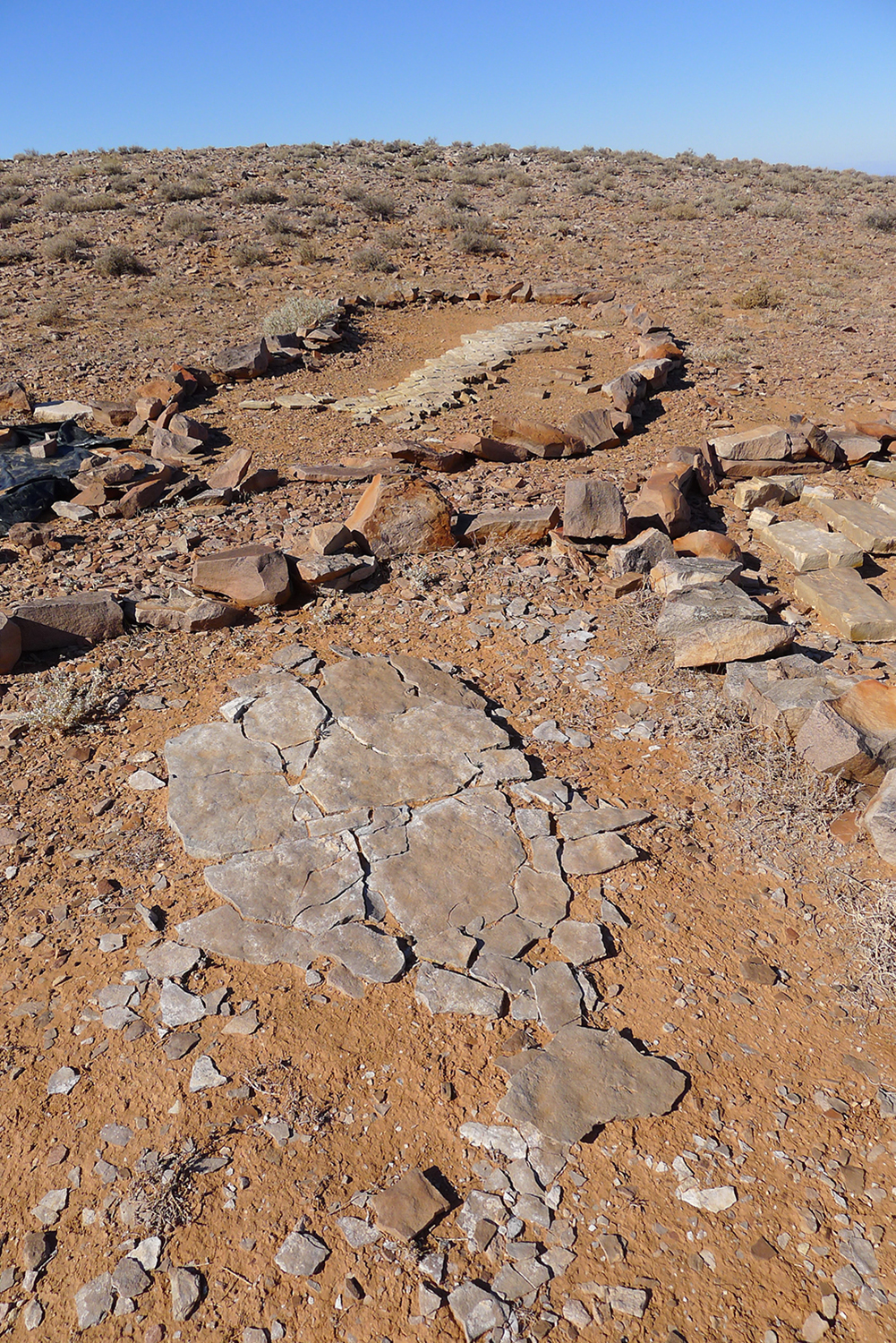
Ediacara fossil site at Nilpena, about 500 km north of Adelaide, South Australia.
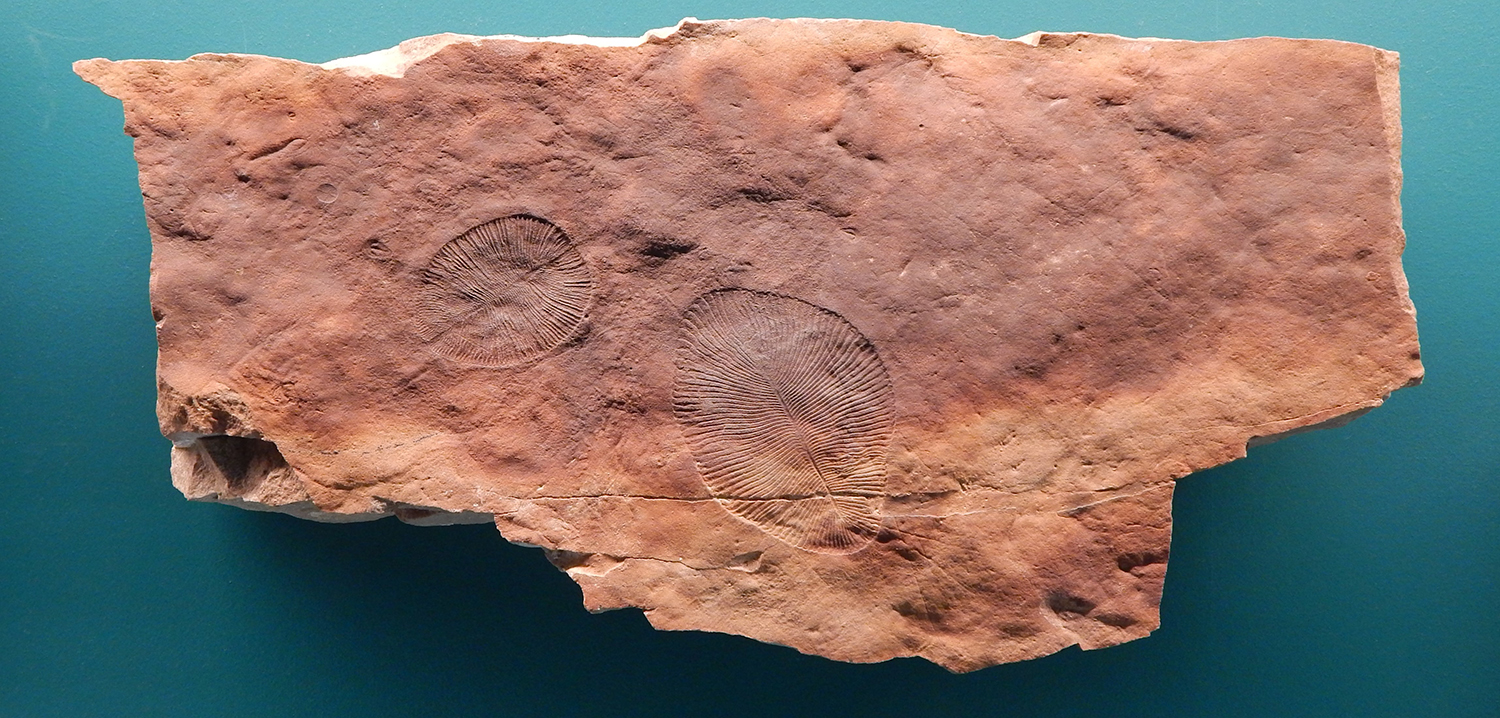
Dickinsonia fossils, found prevalently in a distinct layer of rock in the Flinders Ranges known to geologists as the Ediacara
Member. This specimen is in the collection of the South Australian Museum. Dickinsonia was among the first of the soft-bodied
Ediacaran organisms to be discovered in the Ediacara Hills by the late geologist Reg Sprigg
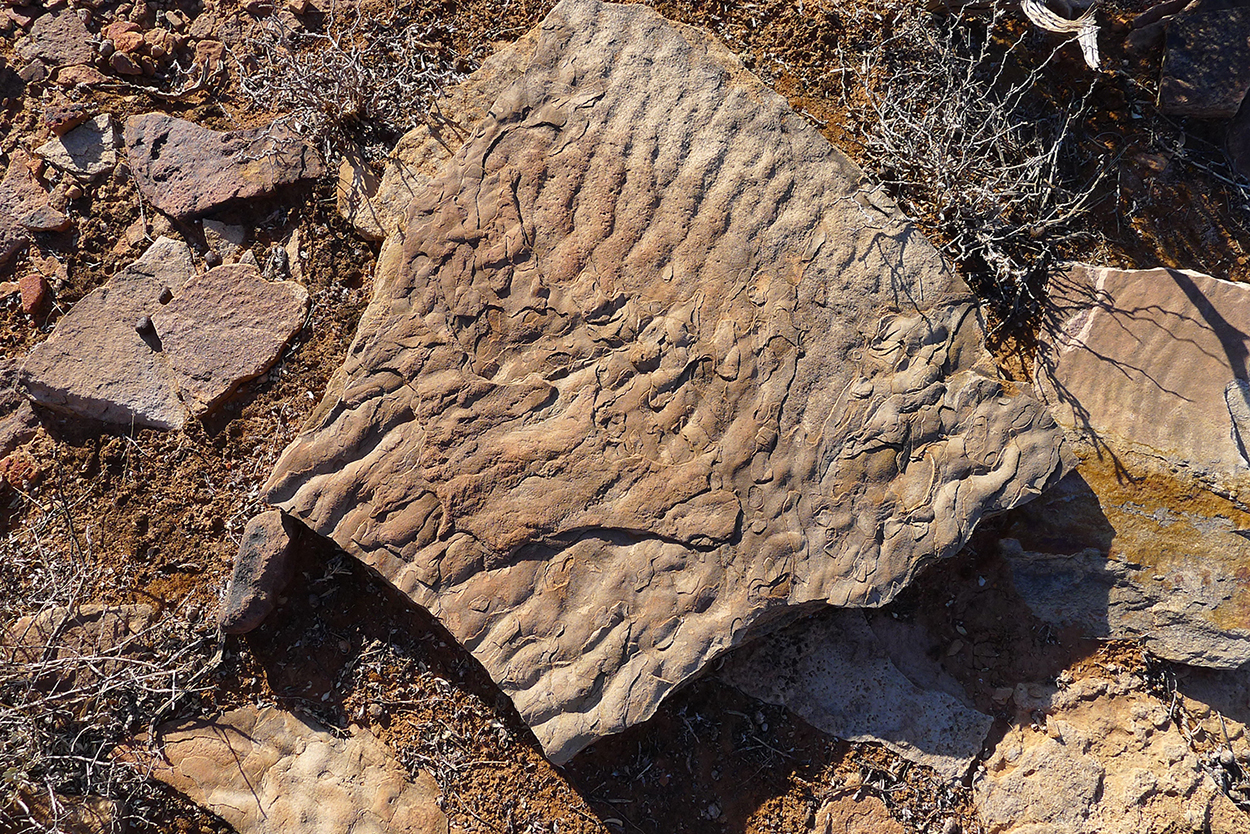
Fossils from the Ediacara fossil site at Nilpena, about 500 km north of Adelaide, South Australia.

Fossils from the Ediacara fossil site at Nilpena, about 500 km north of Adelaide, South Australia.

Fossils from the Ediacara fossil site at Nilpena, about 500 km north of Adelaide, South Australia.

collages, Replaying Life’s Tape, 2019.
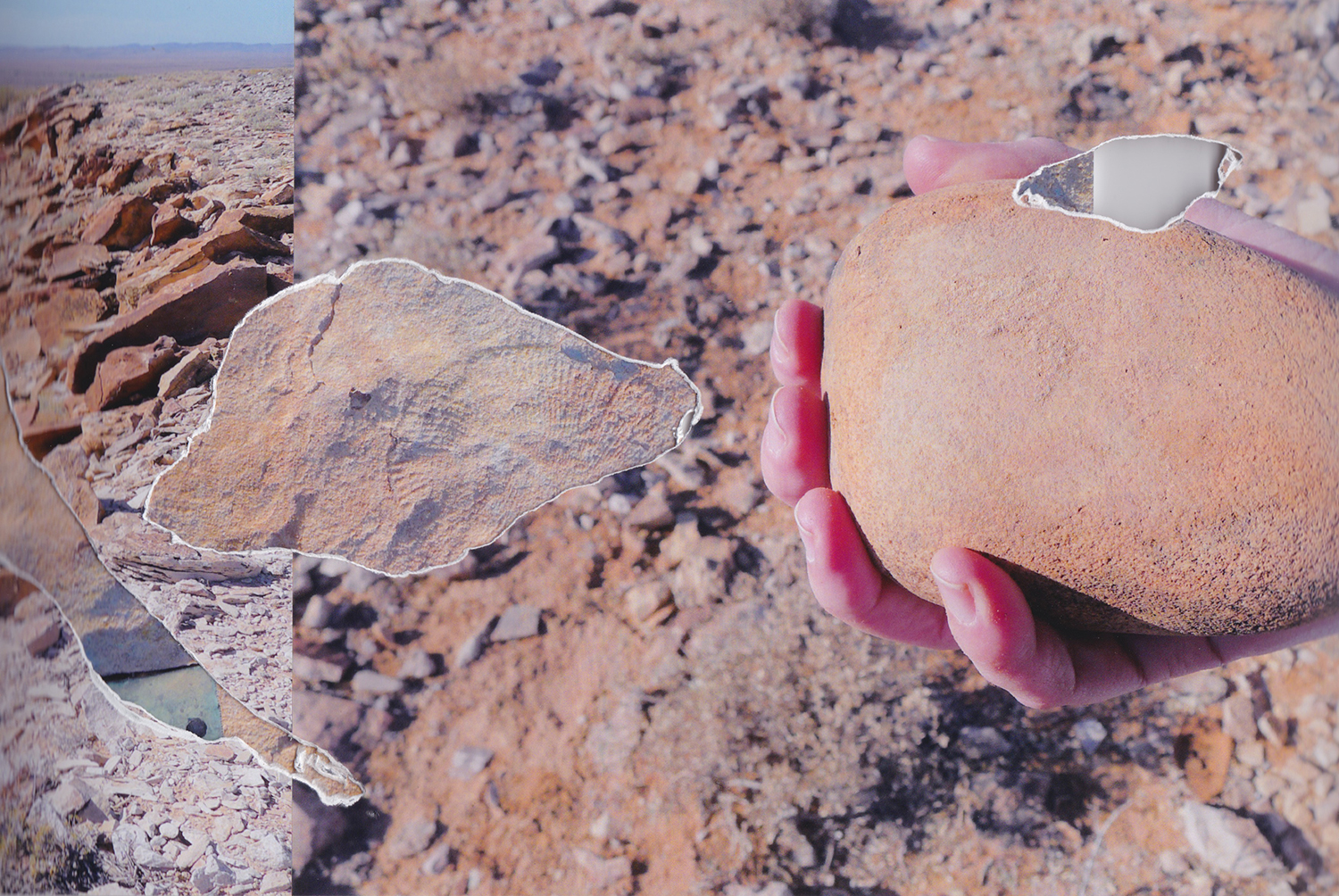
collages, Replaying Life’s Tape, 2019.
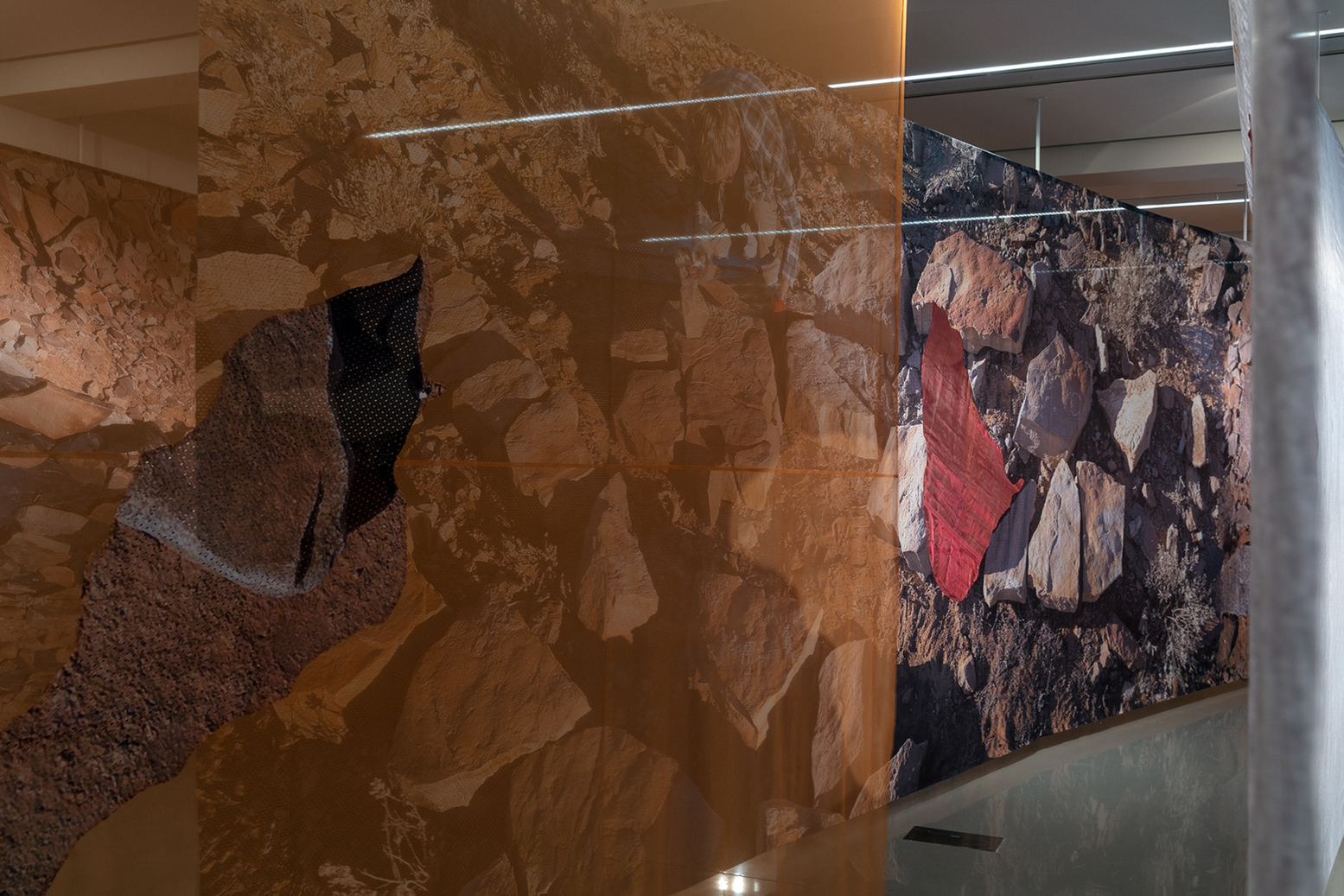
Detail: Once I thought the world was somewhere else, 2018
Printed flag polyester and polymesh, with crinoline and rust coloured mesh inserts

Installation view Replaying Life’s Tape, Monash University Museum of Art, Melbourne, Australia, 2019.

Detail: Once I thought the world was somewhere else, 2018
Printed flag polyester and polymesh, with crinoline and rust coloured mesh inserts

Installation view Replaying Life’s Tape, Monash University Museum of Art, Melbourne, Australia, 2019.
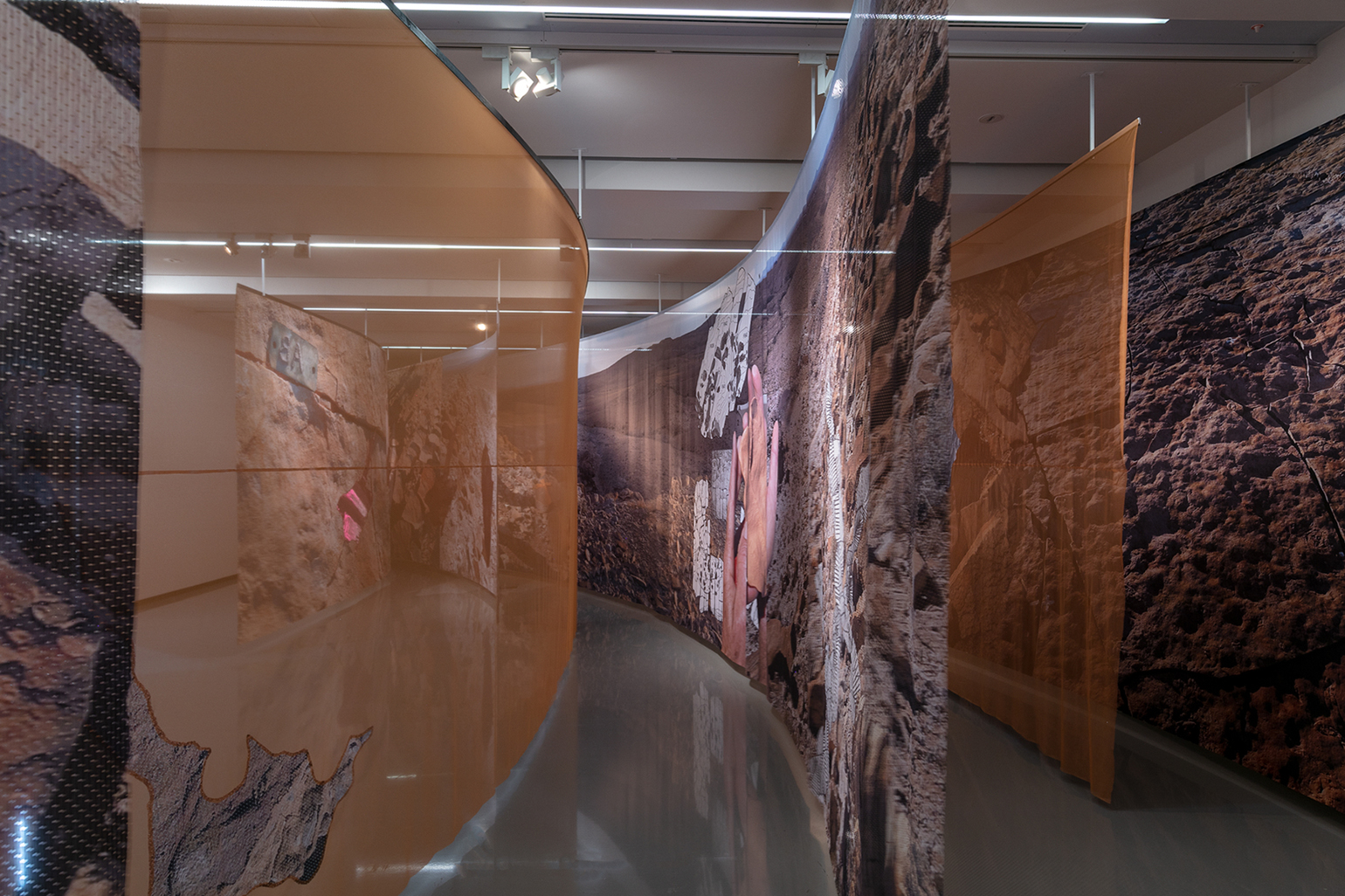
Installation view Replaying Life’s Tape, Monash University Museum of Art, Melbourne, Australia, 2019.

Detail: Once I thought the world was somewhere else, 2018
Printed flag polyester and polymesh, with crinoline and rust coloured mesh inserts
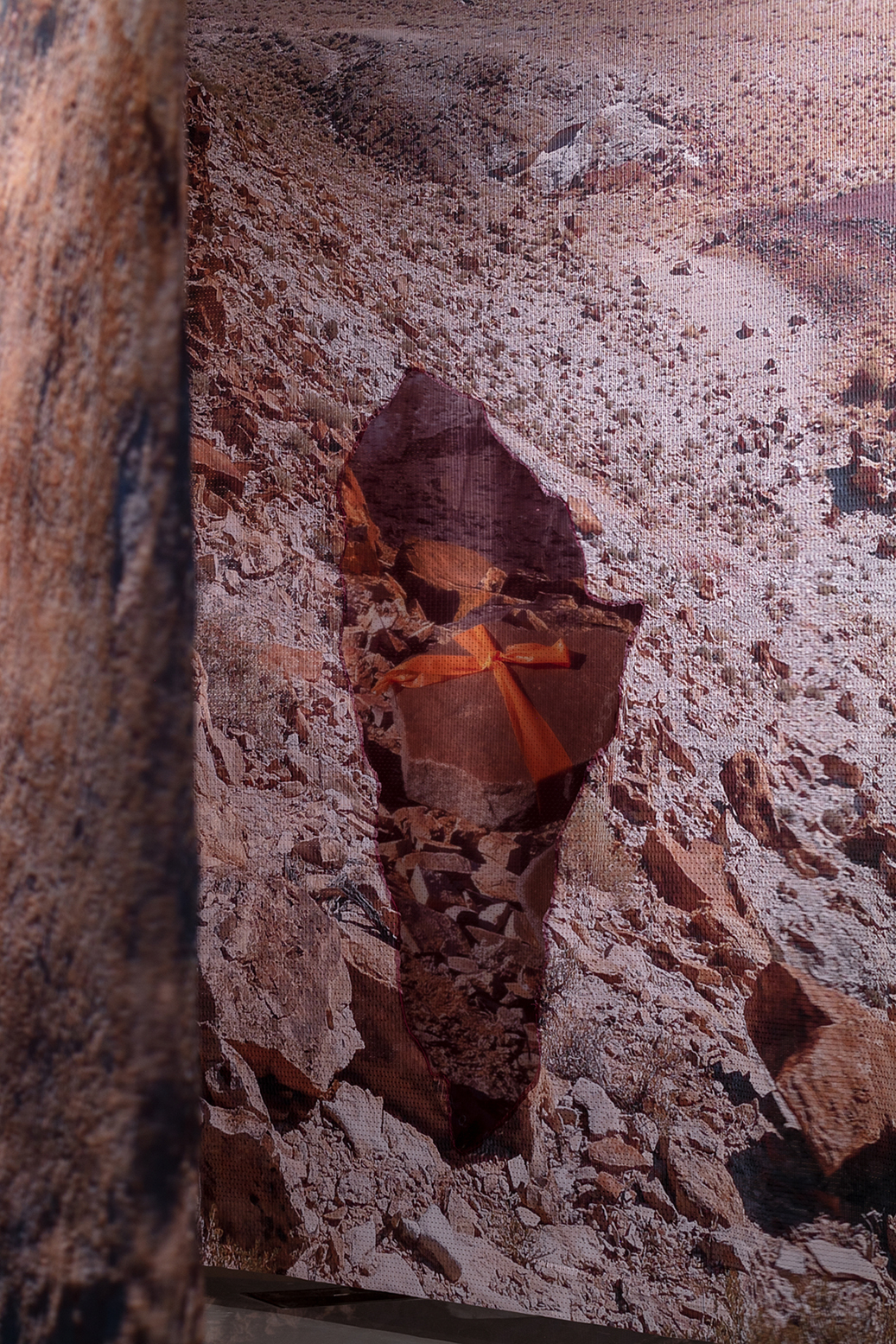
Detail: Once I thought the world was somewhere else, 2018
Printed flag polyester and polymesh, with crinoline and rust coloured mesh inserts
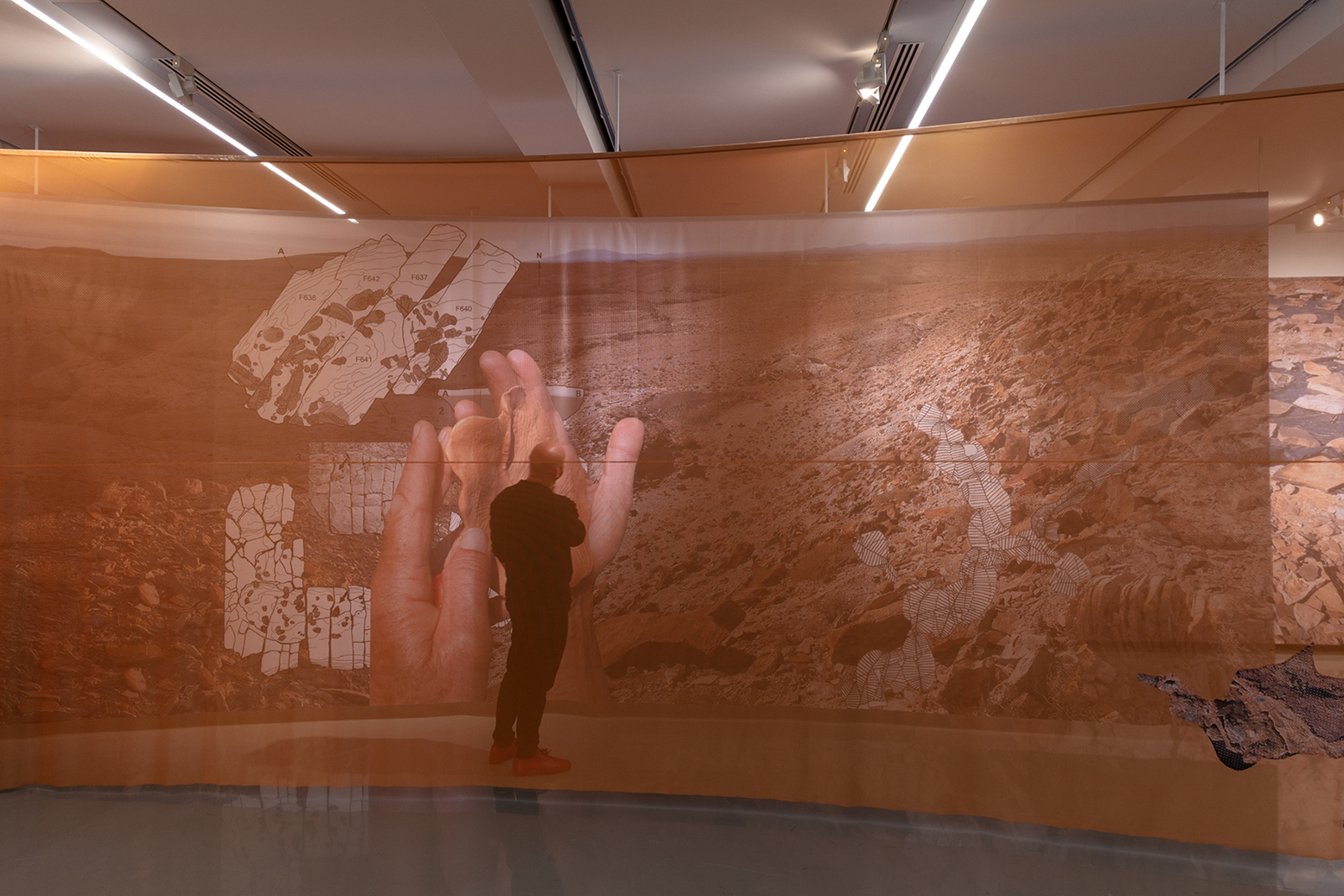
Detail: Once I thought the world was somewhere else, 2018
Printed flag polyester and polymesh, with crinoline and rust coloured mesh inserts
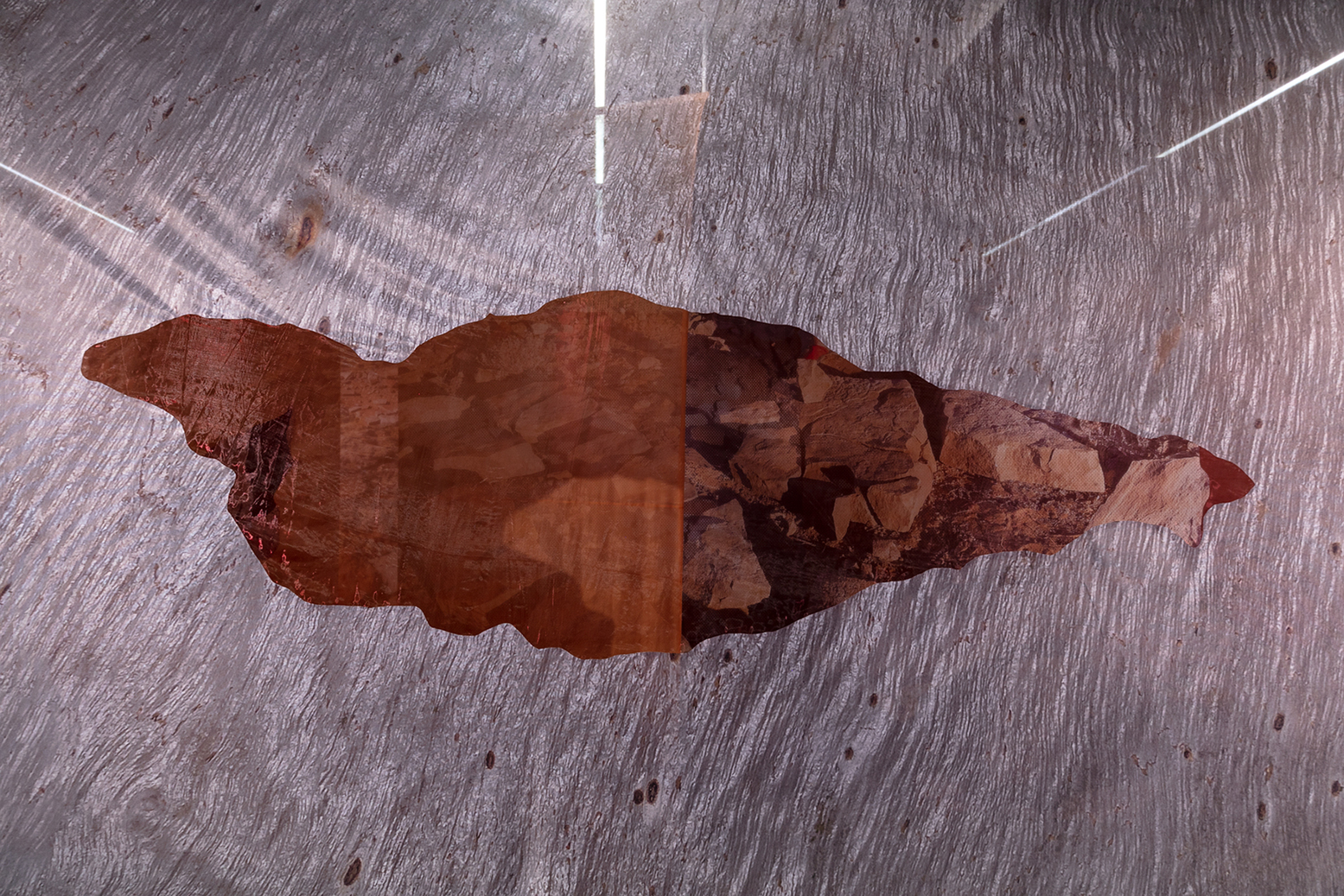
Detail: Once I thought the world was somewhere else, 2018
Printed flag polyester and polymesh, with crinoline and rust coloured mesh inserts
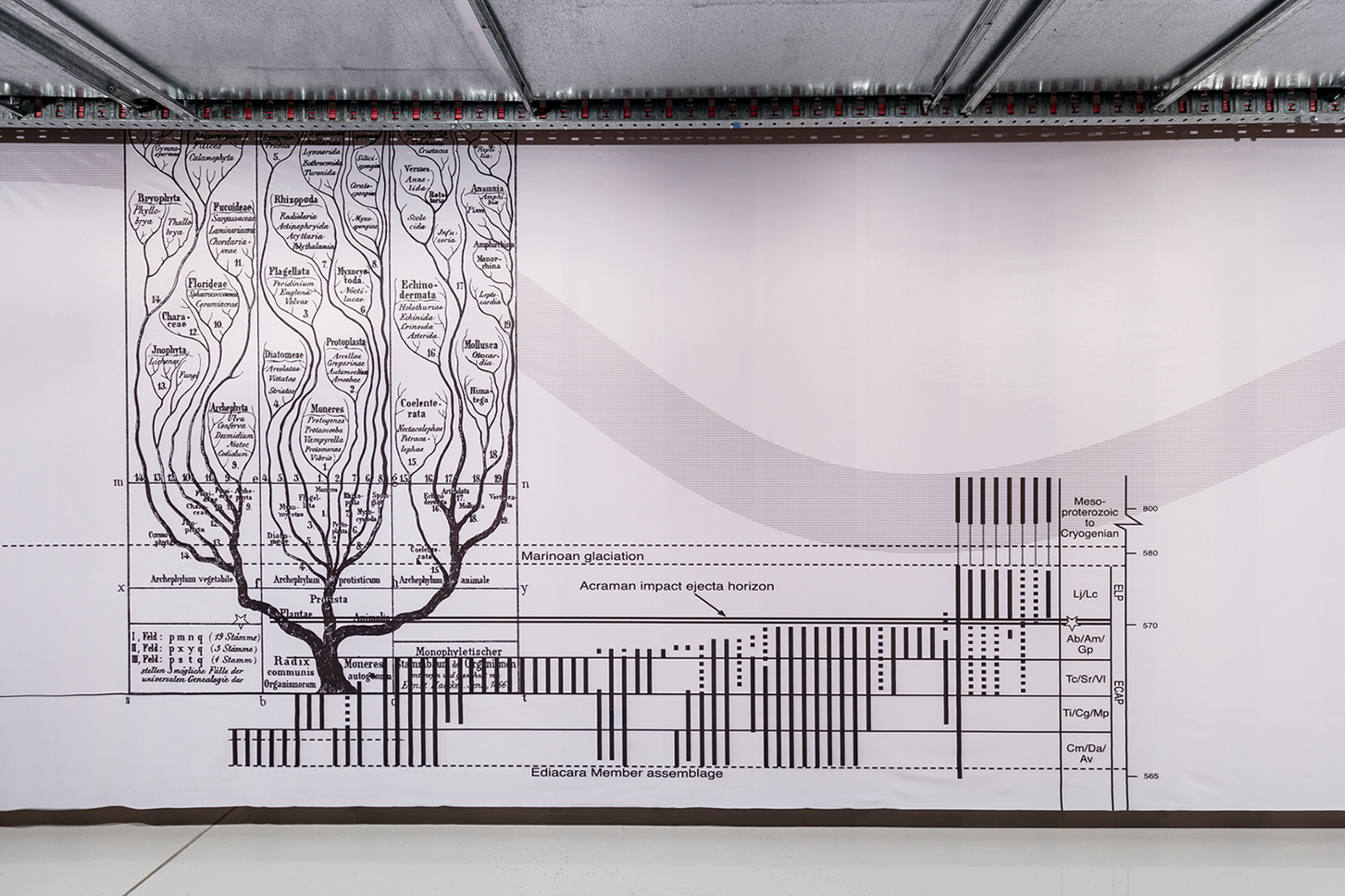
Detail: Twice I looked and saw the world was still there, 2018
printed flag polyester
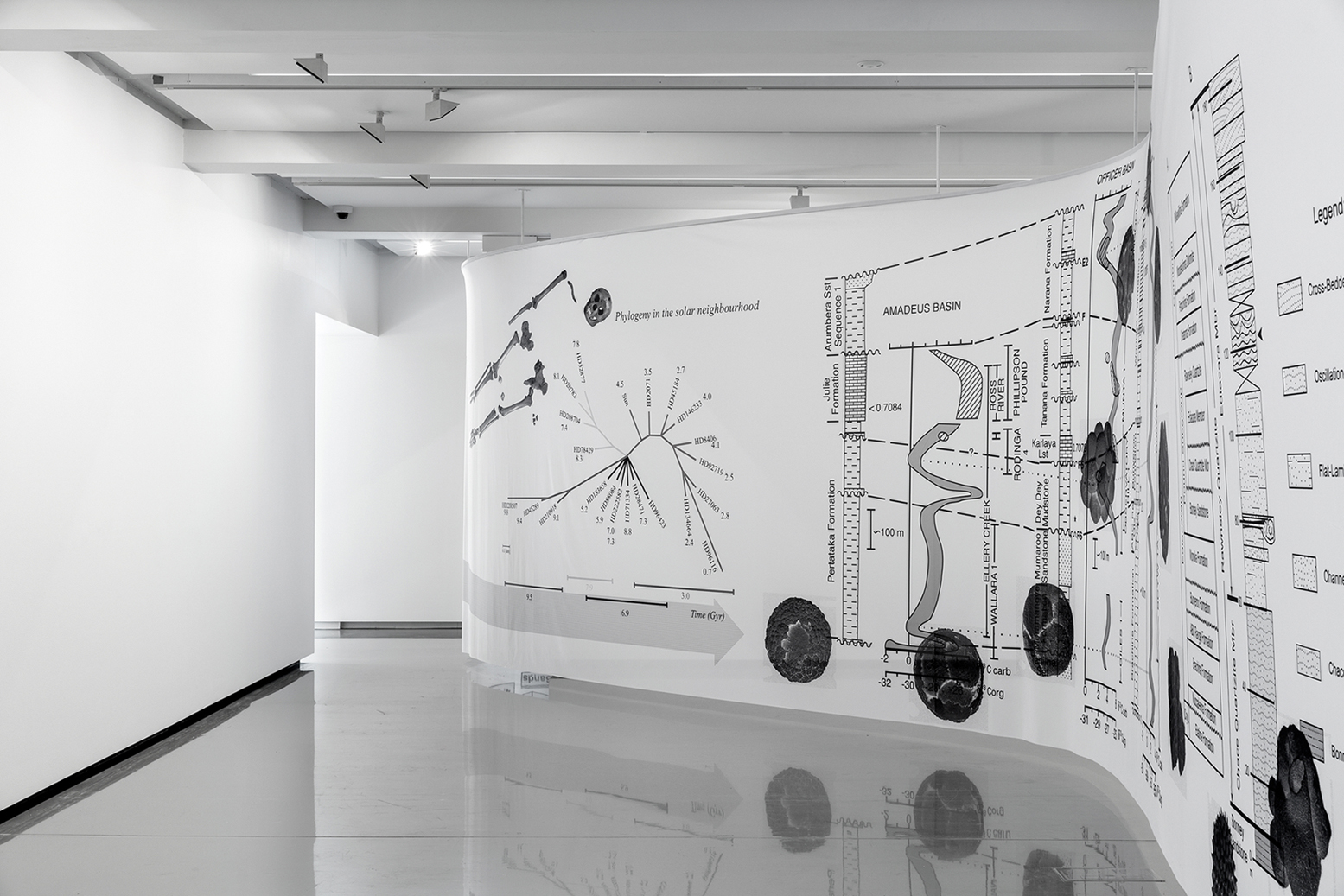
Detail: Twice I looked and saw the world was still there, 2018
printed flag polyester
The installation, weaving through the gallery spaces, explores evolutionary scientific thought as much as this specific Ediacaran chapter and site. Its three main elements—a layered and immersive textile diorama composed from colour photographs taken by the artist during her fieldwork; and a large curving sheet of white fabric printed with diagrammatic forms of information. In addition, several fossils and fossil casts relating to the Ediacaran period are on display on loan from Museums Victoria.
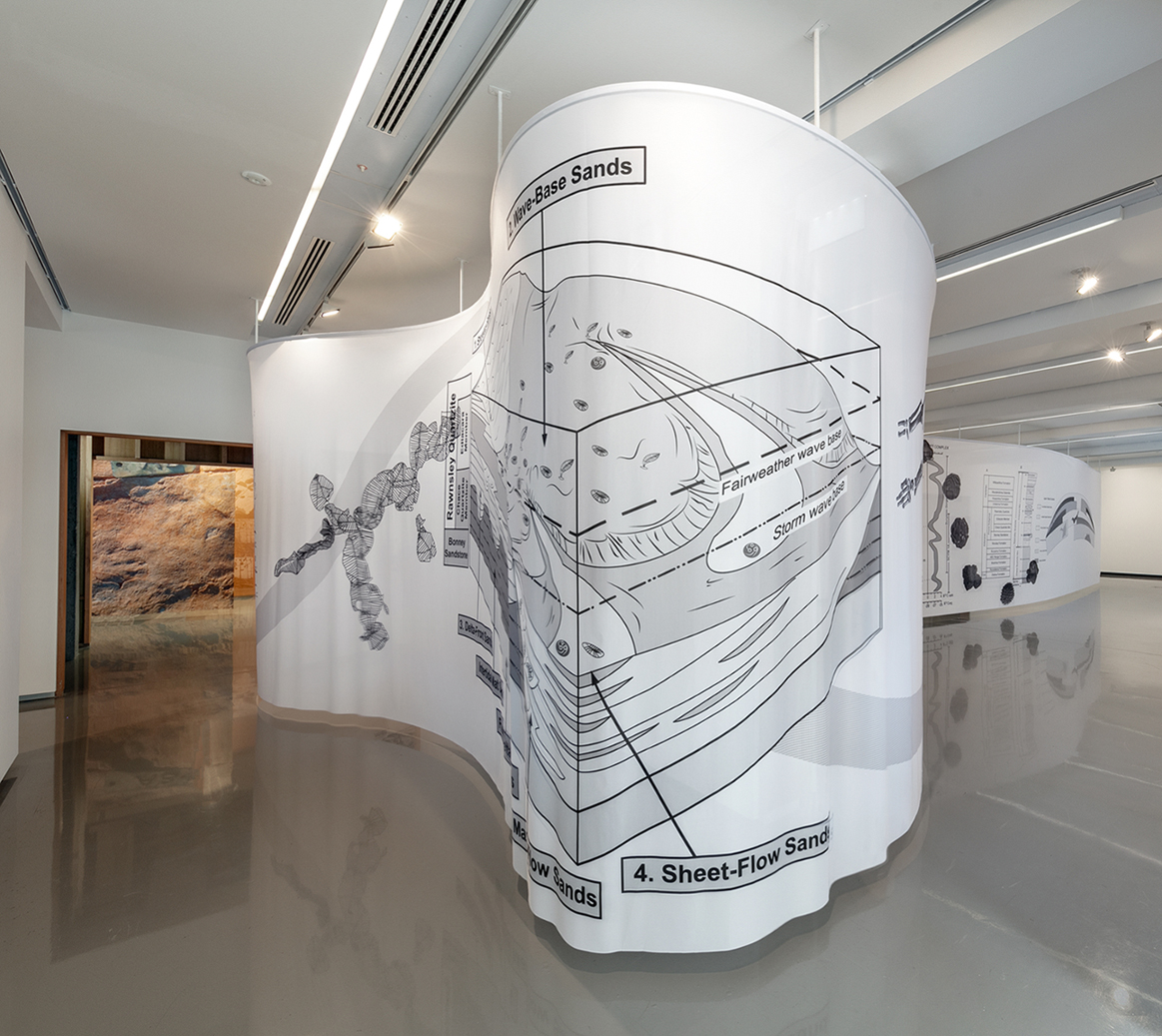
Twice I looked and saw the world was still there, 2019
Installation view Replaying Life’s Tape, Monash University Museum of Art, Melbourne, Australia, 2019.

Twice I looked and saw the world was still there, 2019
Installation view Replaying Life’s Tape, Monash University Museum of Art, Melbourne, Australia, 2019.
PLEASURES OF
ASSOCIATION,
AND POISSINS,
SUCH AS LOVE–
Galerie Wedding, Berlin October 6 – November 4, 2017
Curated by Solvej Helweg Ovesen
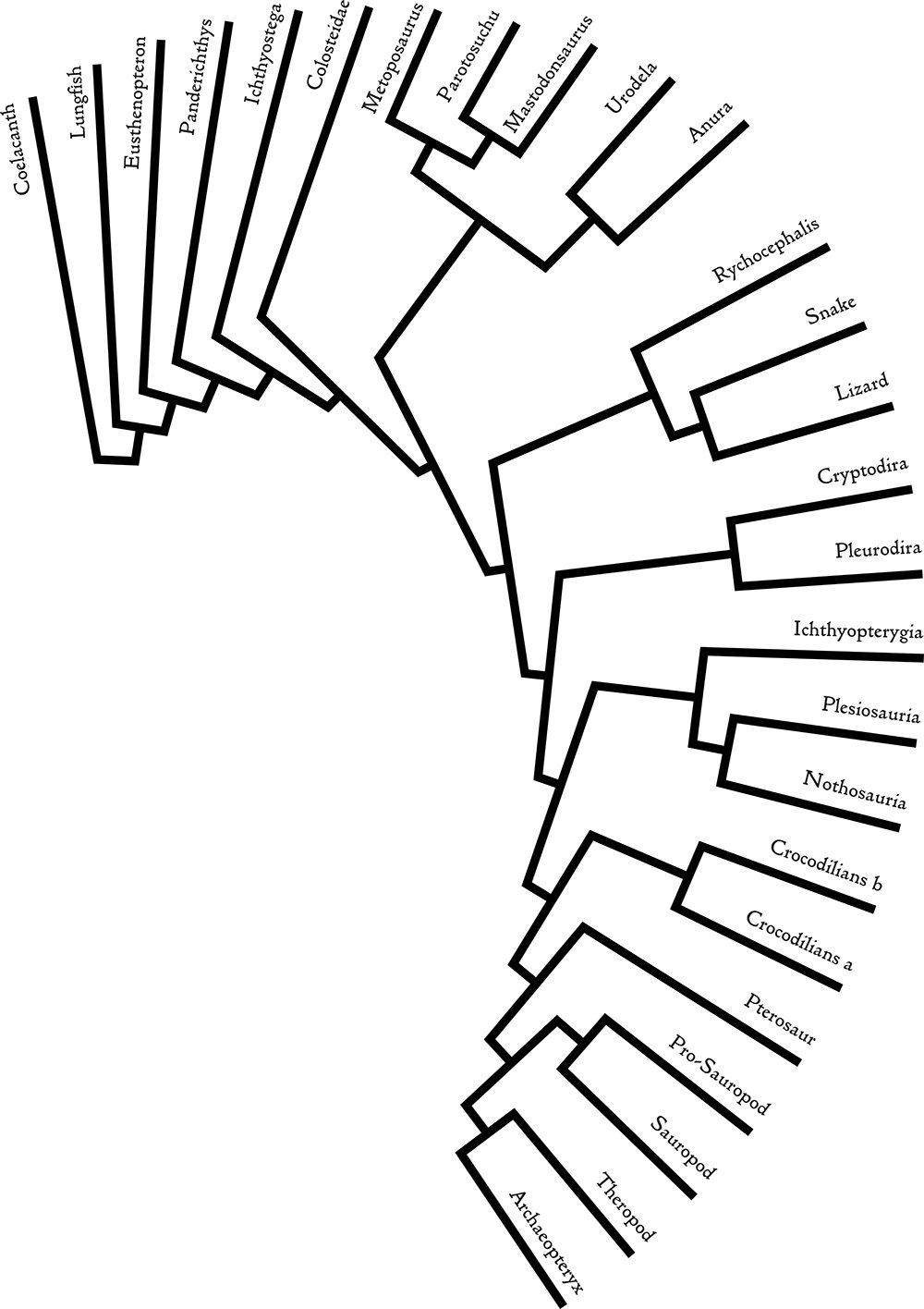
Phylogenetic tree devised by Studio Castillo Deball for Pleasures of Association, and Poissons, such as Love–, 2017.
Pleasures of association, and poissons, such as love– consists of a space enveloping spiral installation of an evolutionary tree. It was created in dialogue with paleontologists Florian Witzmann and Daniela Schwarz. The spiral structure in the exhibition presents ink rubbings on paper of fossil samples of the evolutionary process of 200 million years of vertebrate from water to flight (roughly from fish to bird). The tree does not include the human species, nor human time. Apart from the fact that humans did not exist then, this also reminds us that our existence does not state the end of evolution. However, we humans, have the privilege to be able to fantasize about evolution of the species, and thus create or even redesign the evolutionary order. This is the anthropocentric aspect of the creation of evolutionary tree that the exhibition and title negotiates.
The title Pleasures of association, and poissons, such as love–, is a twist of a diary note by geologist, zoologist and evolutionary biologist Charles Darwin, written during one of his expeditions as he developed his theory of natural selection of populations in 1838. Here he finds "… an analogy between pleasures of association, and pleasures such as love –" in his comparative and connective work that led to "On the Origin of Species by Means of Natural Selection, or the Preservation of Favoured Races in the Struggle for Life", 1859.

Installation view Pleasures of Association, and Poissons, such as Love–, Galerie Wedding Berlin, Germany 2017. Photo: Anastasia Muna.
If anything, Darwin is known for his novel idea that all species developed from one and the same organism or origin, and that species’ populations develop according to the survival of the fittest: natural selection. The title of the exhibition focuses rather on the pleasure of association when looking at the diagram of evolution in the exhibition. This artistic version of an evolutionary tree begins with a fossil of a fish. So, replacing Darwins’ "passions" with the word "poissons" in the title (the French word for fish), refers to the species the diagram begins with.
Although very fascinating, the long line of scientific battles about the origin of life, survival, extinction and the ordering of the species is also poisonous. On a methodological level - how to order evolution - there is an inherent brutality as it always also involves the conflict of who survives and why? It also involves the battle between differing techniques of generating scientific arguments, facts, serving a certain view on evolution. In dialogue with evolutionary biologist Gabriela Aguileta, Deball discovered how dramatically the study of evolution has changed with technology, genetic research, and the development of phylogenetic trees.

Museum für Naturkunde Leibniz-Institut für Evolutions- und Biodiversitätsforschung, Berlin.
Process image
This methodology is in strong contrast with comparative anatomy studies. In her notes on making the evolutionary tree, Deball writes, "I (...) considered if it would be possible to put these two worlds together: the territory of tangible fossils that leave an imprint on stone, and the very ethereal and cybernetic study of genetic data."
Pleasures of association, and poissons, such as love–, opens up a physical space of association and connectivity that allows visitors to understand deep time or the scale of evolutionary processes outside of human existence, outside of our own accelerated presence. With the organic spiral shape, with the indication of time (the oldest fossils hang lower, the ones closer to humans in time hang higher) and although different in setting, this evolutionary tree also brings associations back to the optically and socially engaging theatrical or painterly display form.
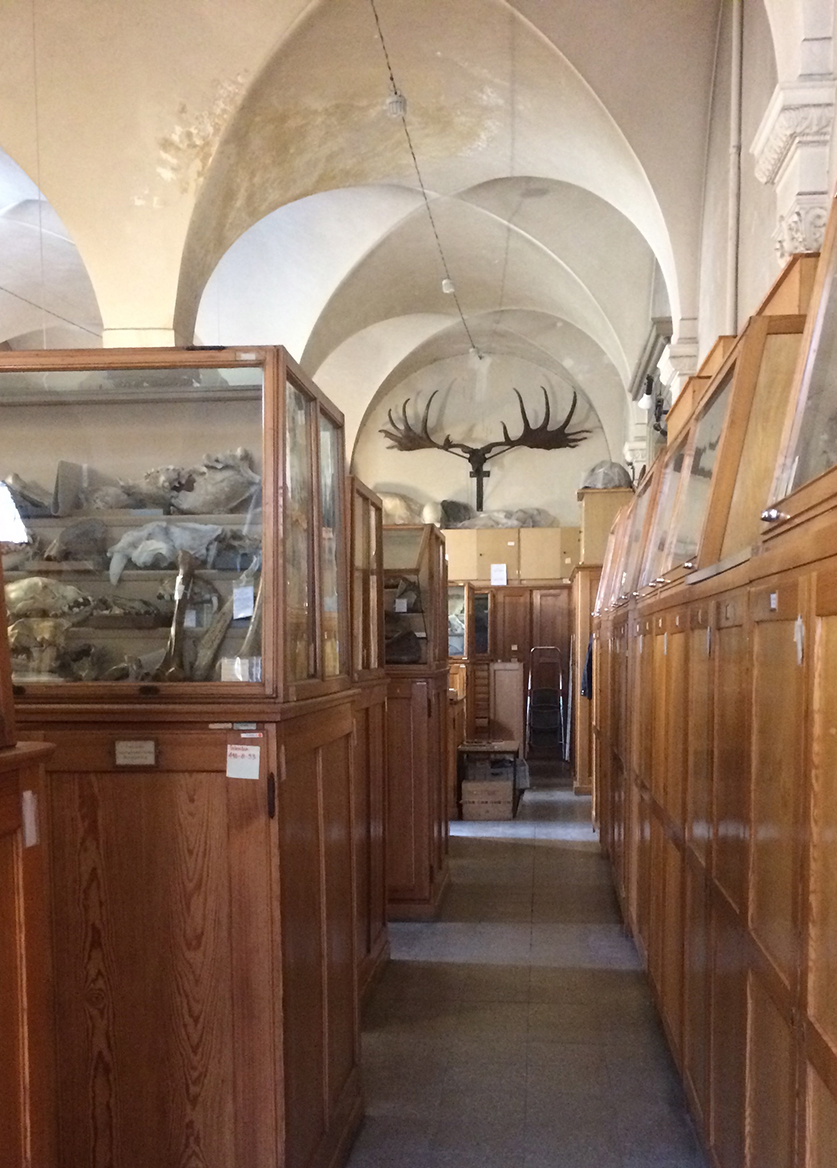
The Museum für Naturkunde in Berlin holds over thirty million collection items, including
fossils and fossil replicas from Europe and around the world.
Its palaeontology collection was used to test the ink rubbing technique employed for Hipótese de uma árvore

First-known evolutionary based tree, “serving to show the origin of the different animals”, from Jean-Baptiste Lamarck’s Philosophie zoologique, 1809.

Detail: Pleasures of Association, and Poissons, such as Love‑, 2017
Bamboo structure, rubbings on Japanese paper, Sumi ink.
Photo: Anastasia Muna.
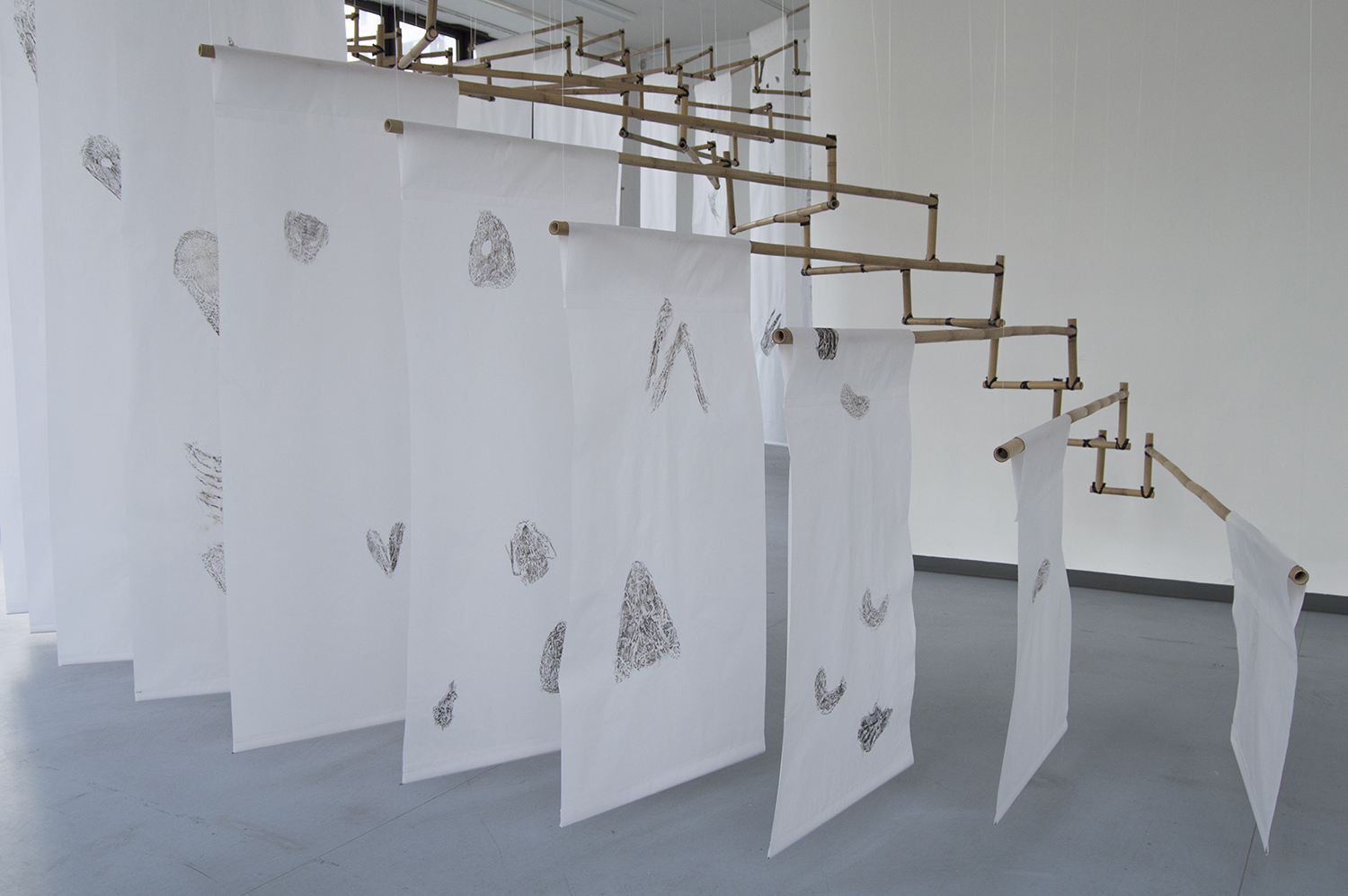
Detail: Pleasures of Association, and Poissons, such as Love‑, 2017
Bamboo structure, rubbings on Japanese paper, Sumi ink.
Photo: Anastasia Muna.
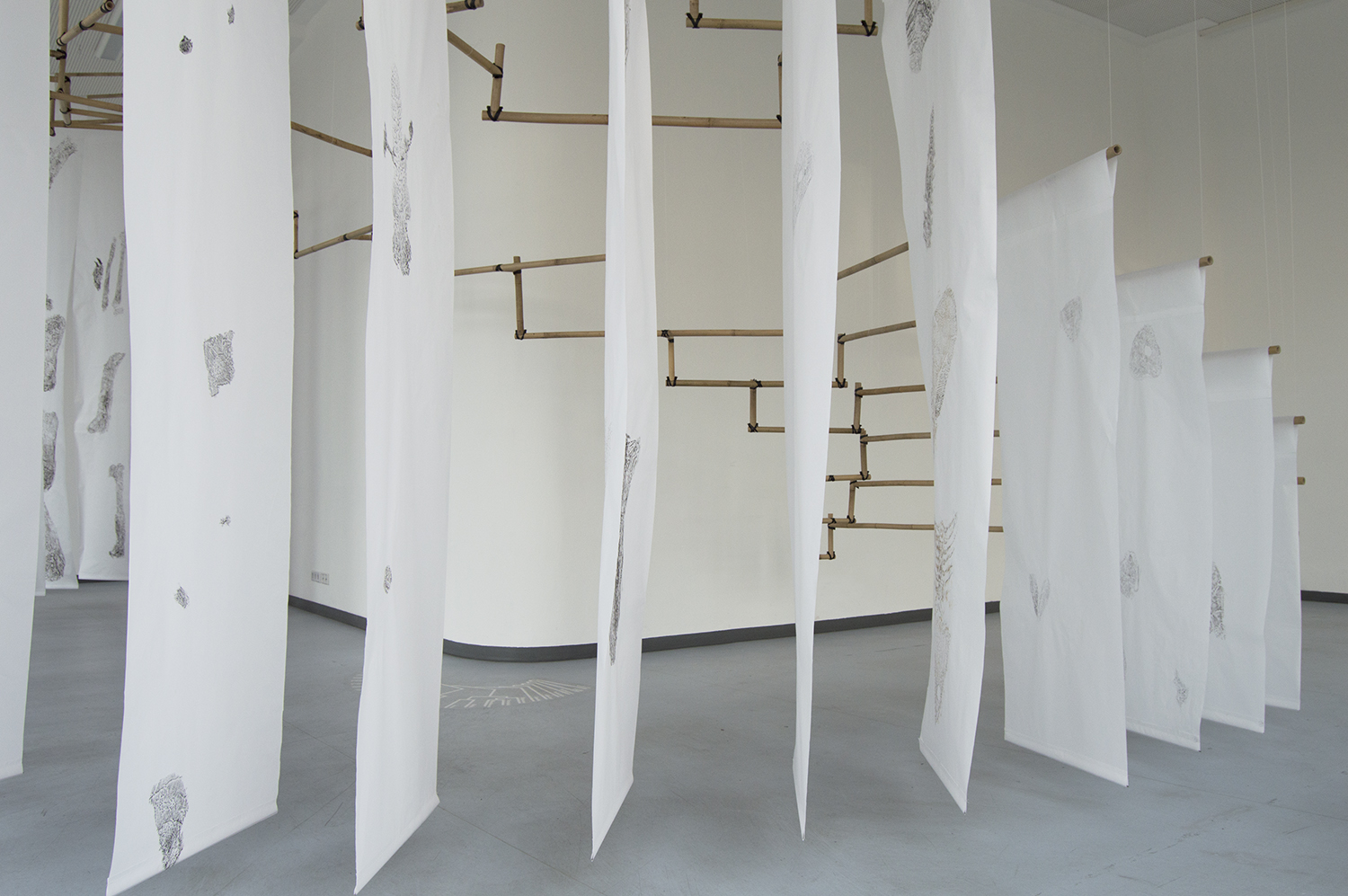
Detail: Pleasures of Association, and Poissons, such as Love‑, 2017
Bamboo structure, rubbings on Japanese paper, Sumi ink.
Photo: Anastasia Muna.
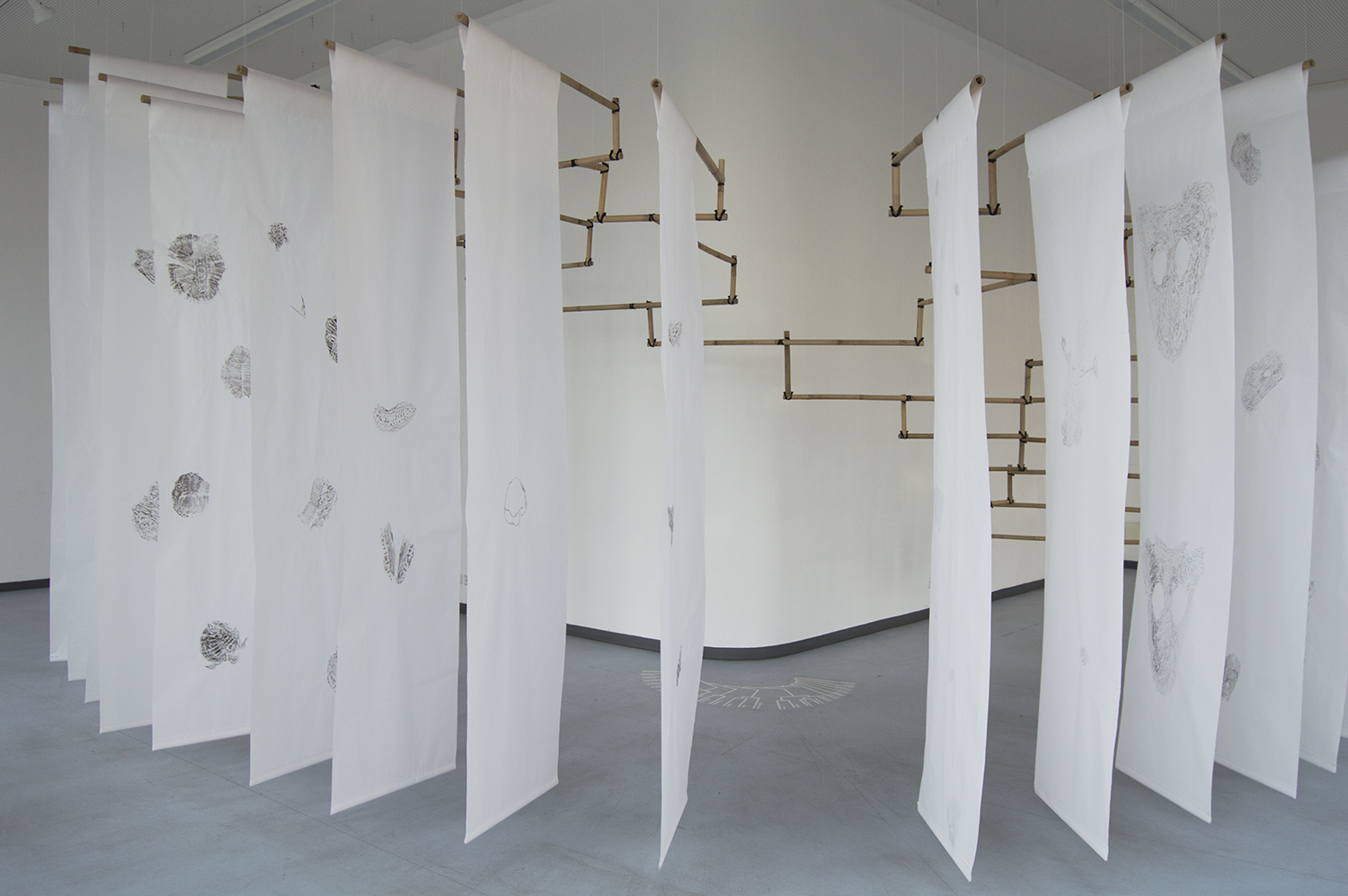
Installation view Pleasures of Association, and Poissons, such as Love–, Galerie Wedding Berlin, Germany 2017.
Photo: Anastasia Muna.
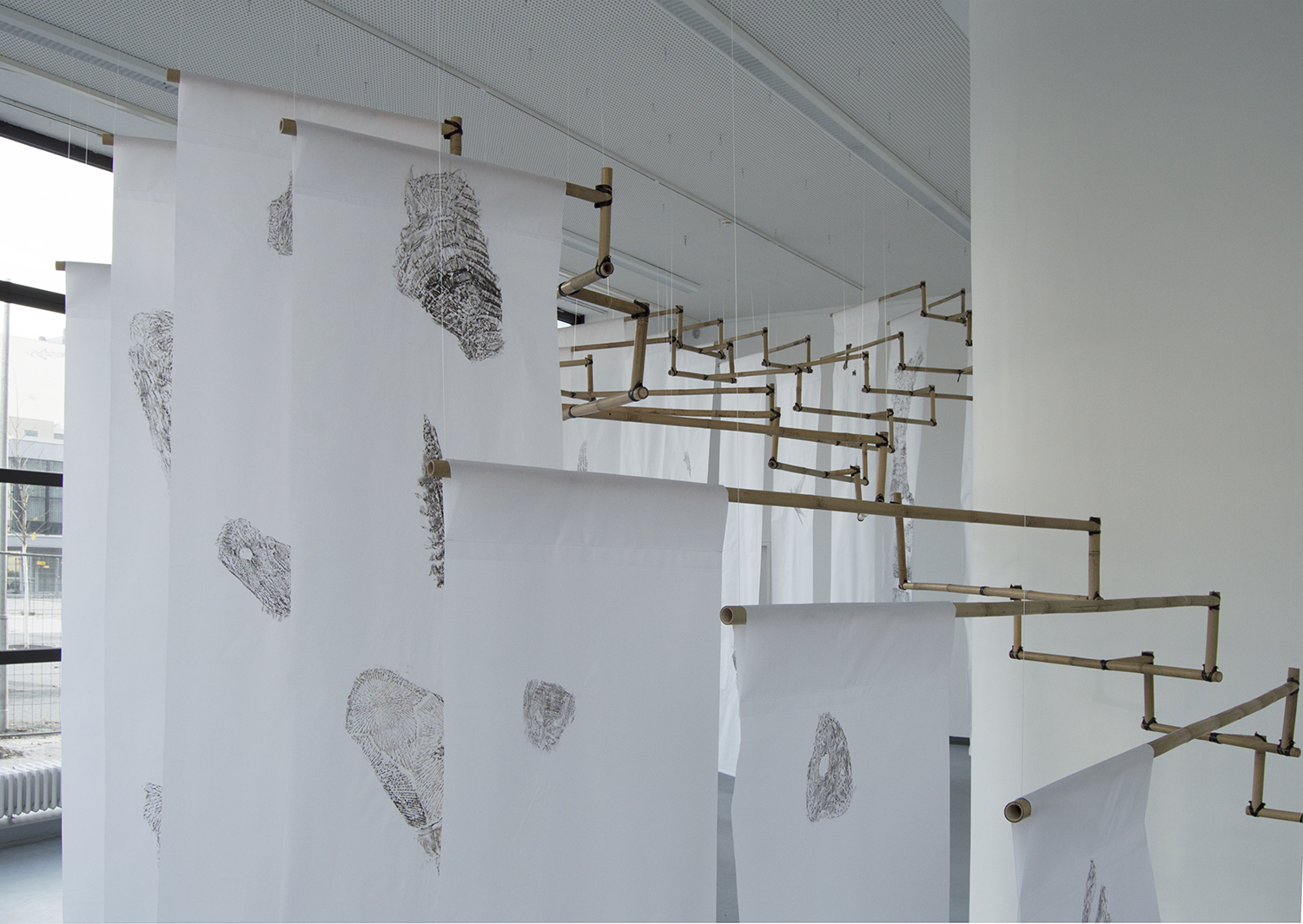
Detail: Pleasures of Association, and Poissons, such as Love‑, 2017
Bamboo structure, rubbings on Japanese paper, Sumi ink.
Photo: Anastasia Muna.
HYPOTHESIS OF A TREE
São Paulo Biennial, Brazil September 7 – December 11, 2016 Curated by Johan Voltz

Phylogenetic tree devised by Studio Castillo Deball for
Hipótese de uma árvore (Hypothesis of a Tree), 2016.
Hypothesis of a Tree (2016) addresses the divergent theories about time pursued across the studies of genetic data and paleontology. The spiralling bamboo structure is based on a phylogenetic tree that diagrams the inferred evolutionary relationships among various biological species based upon similarities and differences in their physical or genetic characteristics. From each of its 56 outer branches hangs a paper rubbing of fossil sediments representing a species.
The drawing technique used for the piece was borrowed from Merle Greene Robertson, an American archaeologist, who conducted extensive research in the Maya region and developed this method of paper rubbing using Japanese paper and ink, leading to the creation of around 5,000 images of monuments. Hypothesis of a Tree reunites the tangible materiality of fossils, which have left their imprint on stone, with the cybernetic study of genomes on the horizon.
A phylogenetic or evolutionary tree is a branching diagram showing the inferred evolutionary relationships among various biological species or other entities—their phylogeny—based upon similarities and differences in their physical or genetic characteristics.
This project started from a conversation with evolutionary biologist Gabriela Aguileta. We spoke about her research and how the field of evolution has been transformed through technological and genetic research advances, as well as through the development of phylogenetic trees. The first question to her was the relationship between palaeontology—the study of fossils—and what she does, which is based in genetic data. She answer that the two disciplines are often in conflict and sometimes have contradictory theories about time. This brought up the question of whether it would be possible to put these two worlds together: the territory of tangible fossils that leave an imprint on stone, and the very ethereal and cybernetic study of genetic data.

Preliminary sketches by Studio Castillo Deball
The research began at the paleontology museum in Solnhofen, in southern Germany, which has an impressive collection of specimens found from the area. The second floor of the Museum is dedicated to the German actor and play writer Johann Alois Senefelder (6 November 1771 – 26 February 1834) who was also the inventor of the lithographic printing process in 1796.
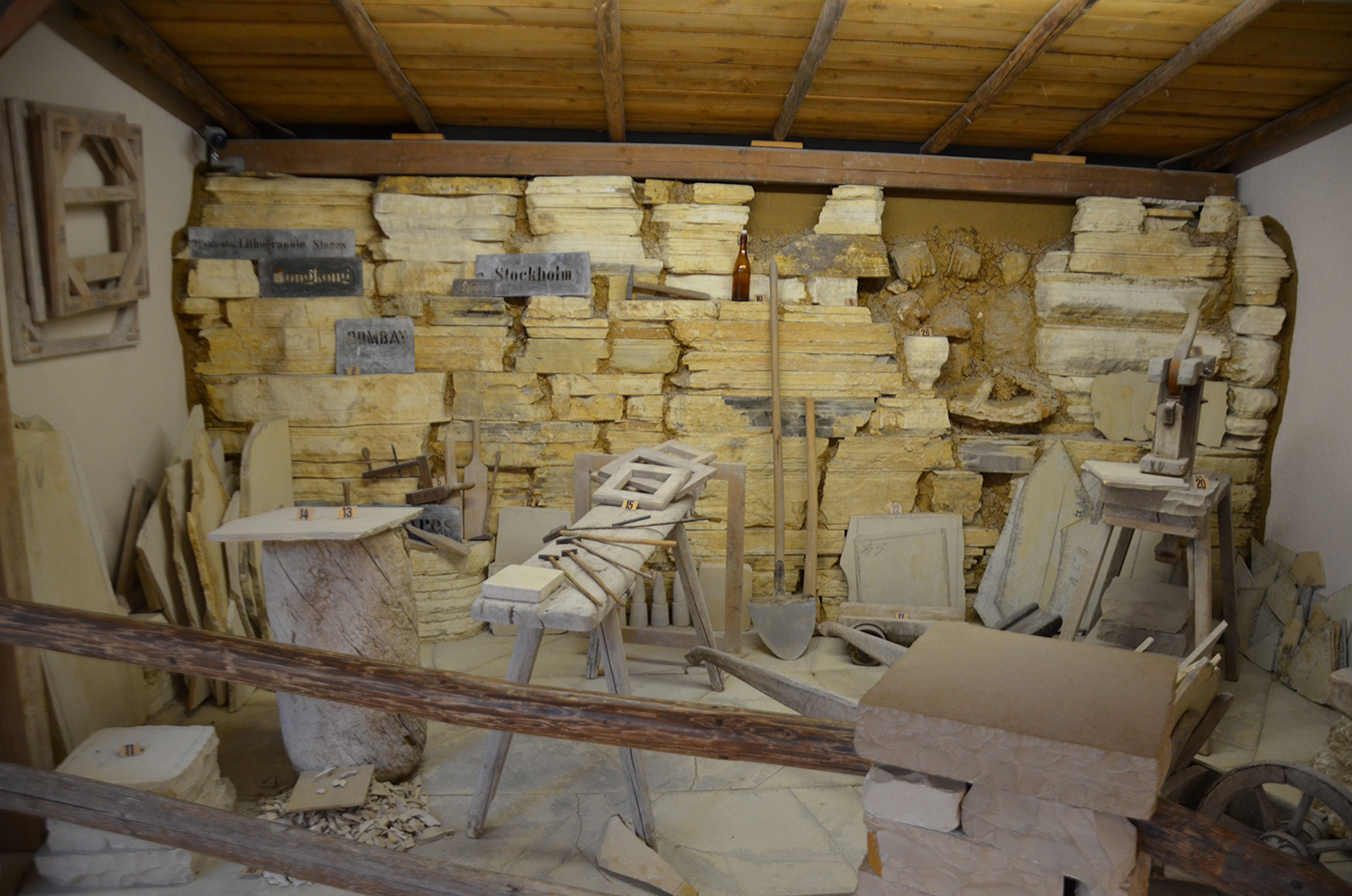
Reproduction of a quarry workshop, Bürgermeister-Müller-Museum, Solnhofen, Germany
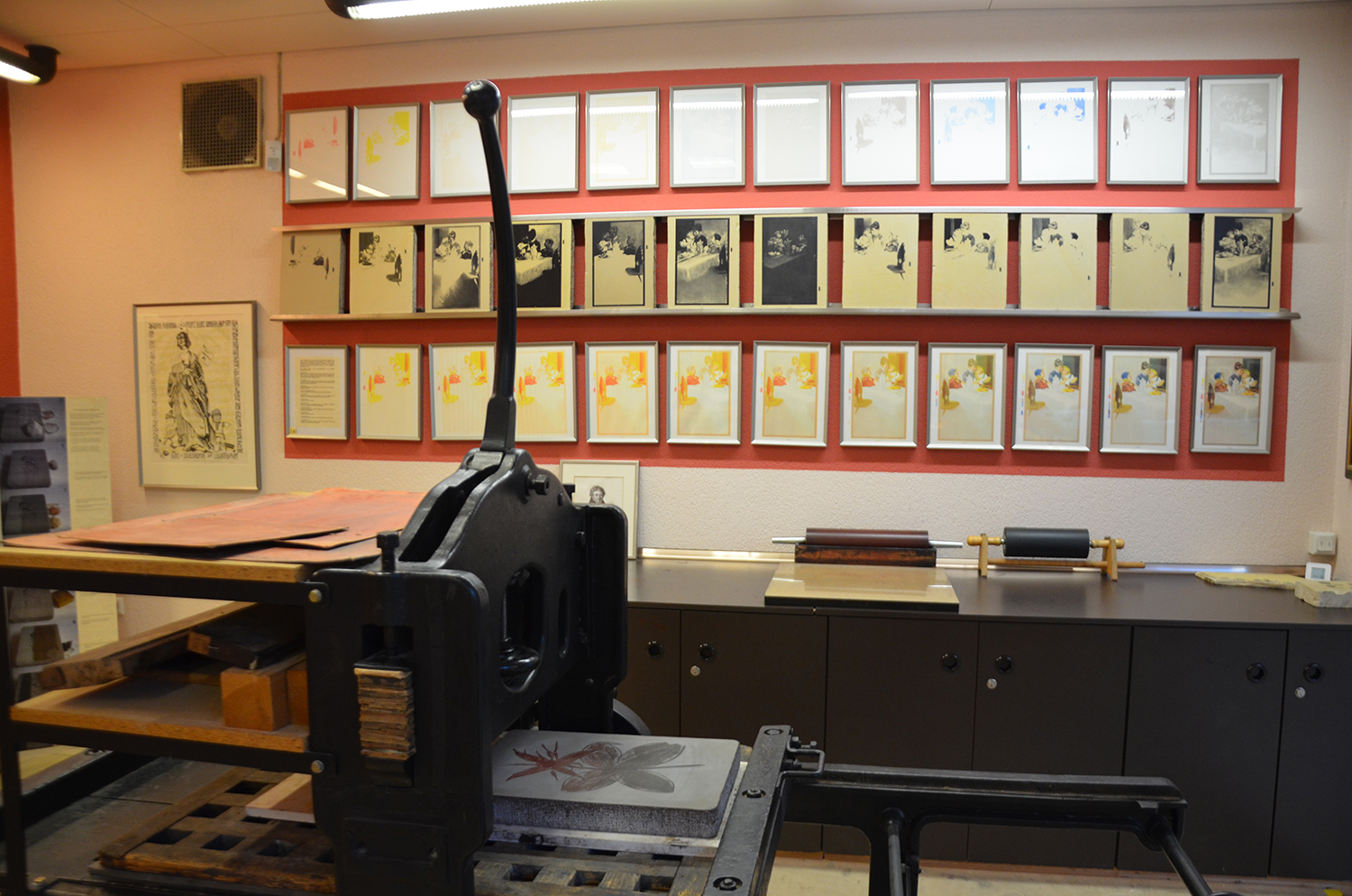
Senefelder’s lithographic workshop, Bürgermeister-Müller-Museum, Solnhofen, Germany
The aim was to build a 3-dimensional phylogenetic tree as a very dense space where the public could experience the huge diversity of species from the inside. Each of the branches of the phylogenetic tree would correspond to a specific species, and would be represented by an ink rubbing on large sheets of Japanese paper.
In Berlin, we meet with paleontologists Dr. Barbara Mohr and Dr. Florian Witzmann at the Museum of Natural History. The museum collects and preserves fossils and fossil replicas from Europe as well as internationally. There we learned more about the Crato Formation in Brazil, and we started to experiment with ink paper rubbings, to see how sensitive the technique is to capture the texture and structure of the actual fossils.
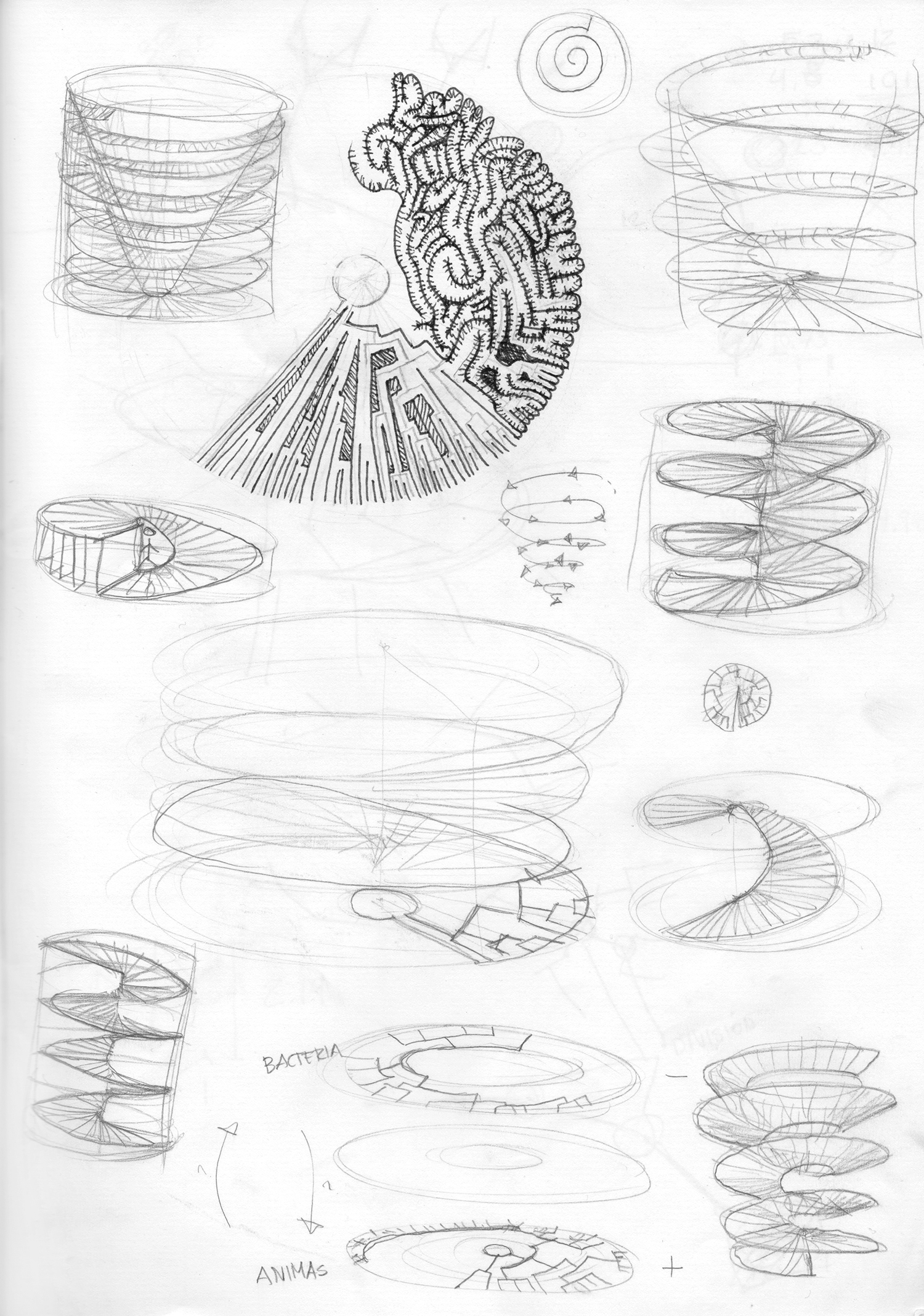
Preliminary sketches by Studio Castillo Deball
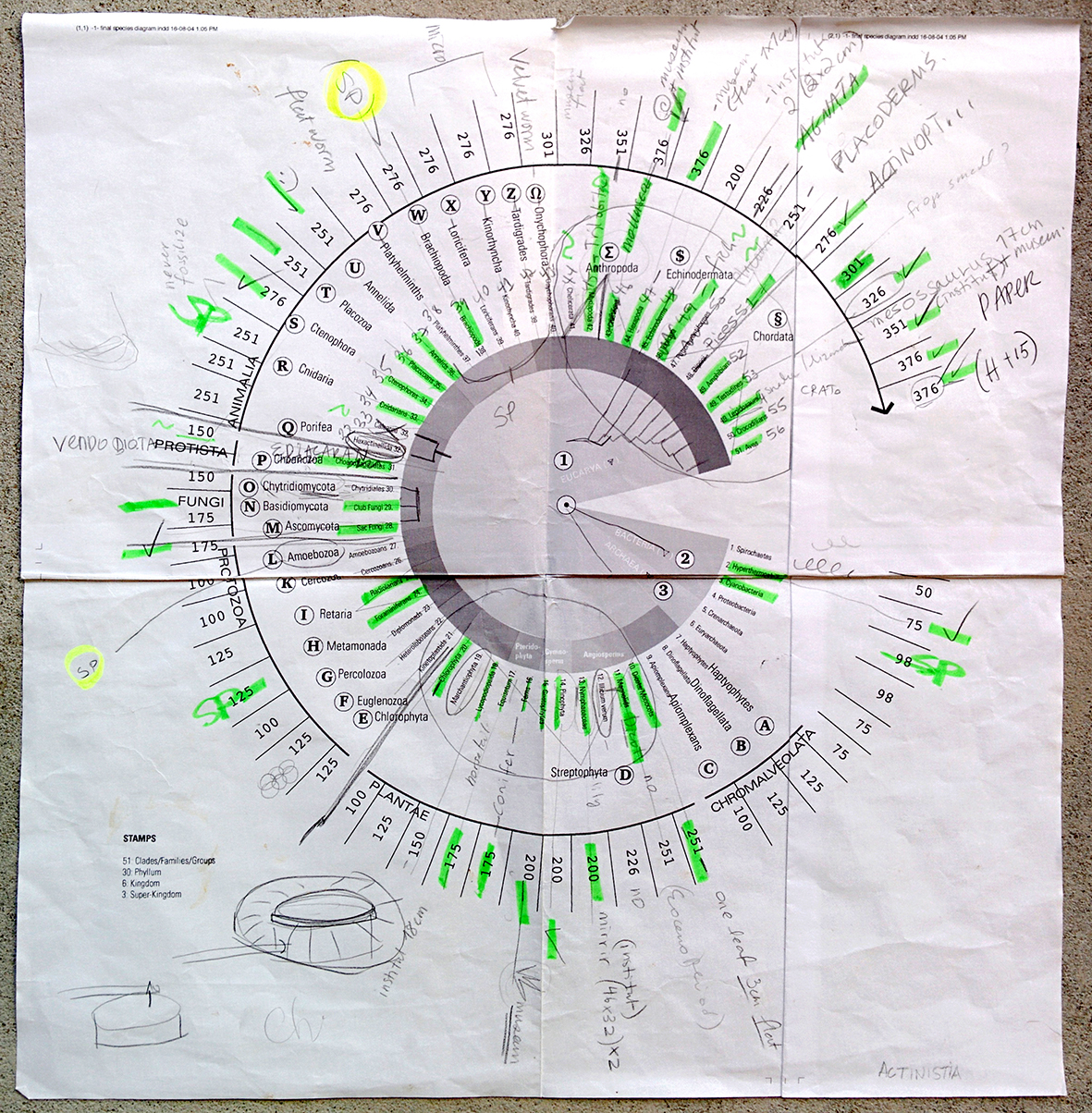
Preliminary sketches by Studio Castillo Deball
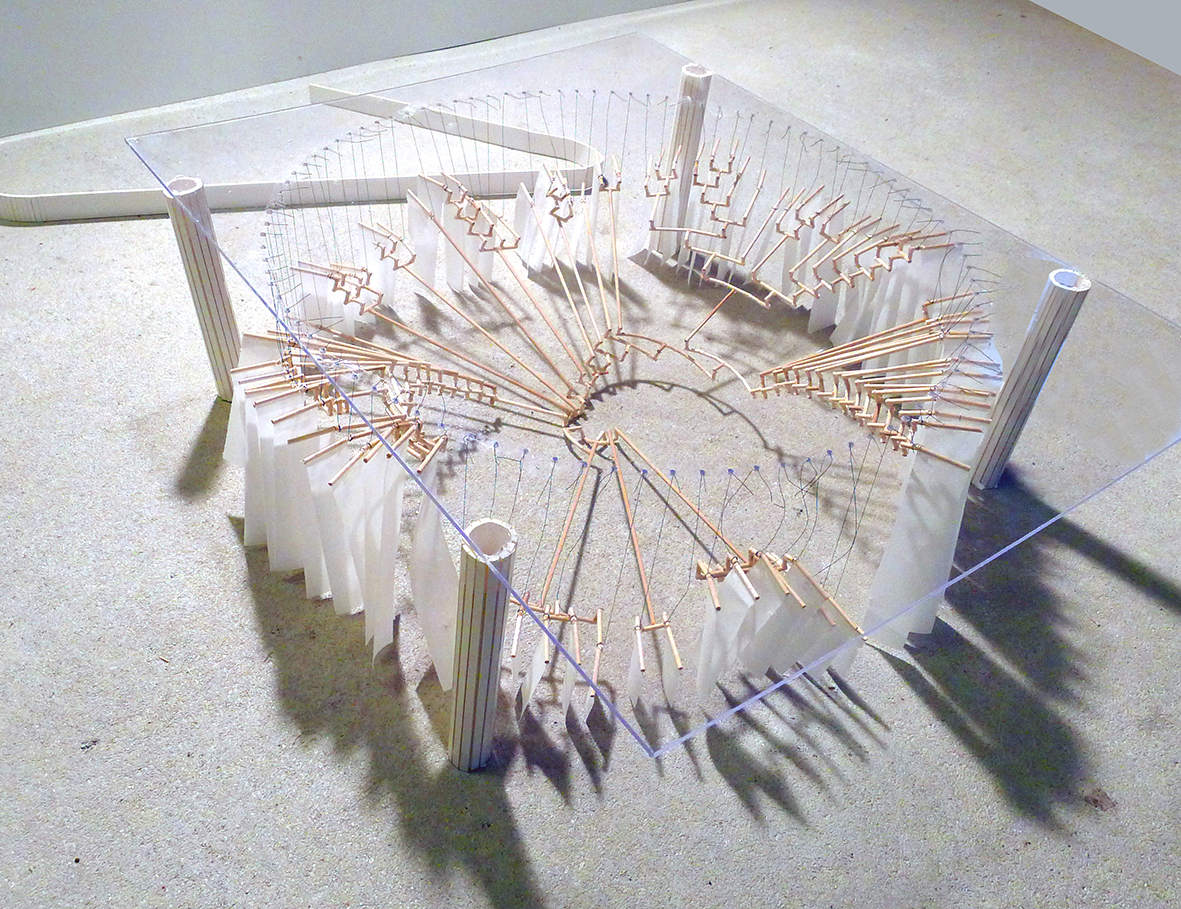
Scale model of Hypothesis of a tree, 2016

Merle Greene circa 1980 at work making one of her rubbings in Bonampak.
The technique used for the piece was borrowed from Merle Greene an American archaeologist, who did extensive research in the Maya region. She recorded several monuments with her paper rubbing technique using Japanese paper and ink, completing around 5000 rubbings of Maya monuments. Surprisingly, this tactile exercise produced very clear images of the stone relief onto the paper; sometimes much more readable than the bare stone itself.

Hard, compact masses of mineral matter, known as ‘calcareous concretions’, removed from Parque dos Pterossauros—an excavation site at Santana do Cariri, Ceará, Brazil.
Popularly known as ‘Pedra de Peixe’ (fish stone), the concretions sometimes also preserve threedimensional fossils of pterosaurs (extinct flying reptiles), dinosaurs, turtles and plants.
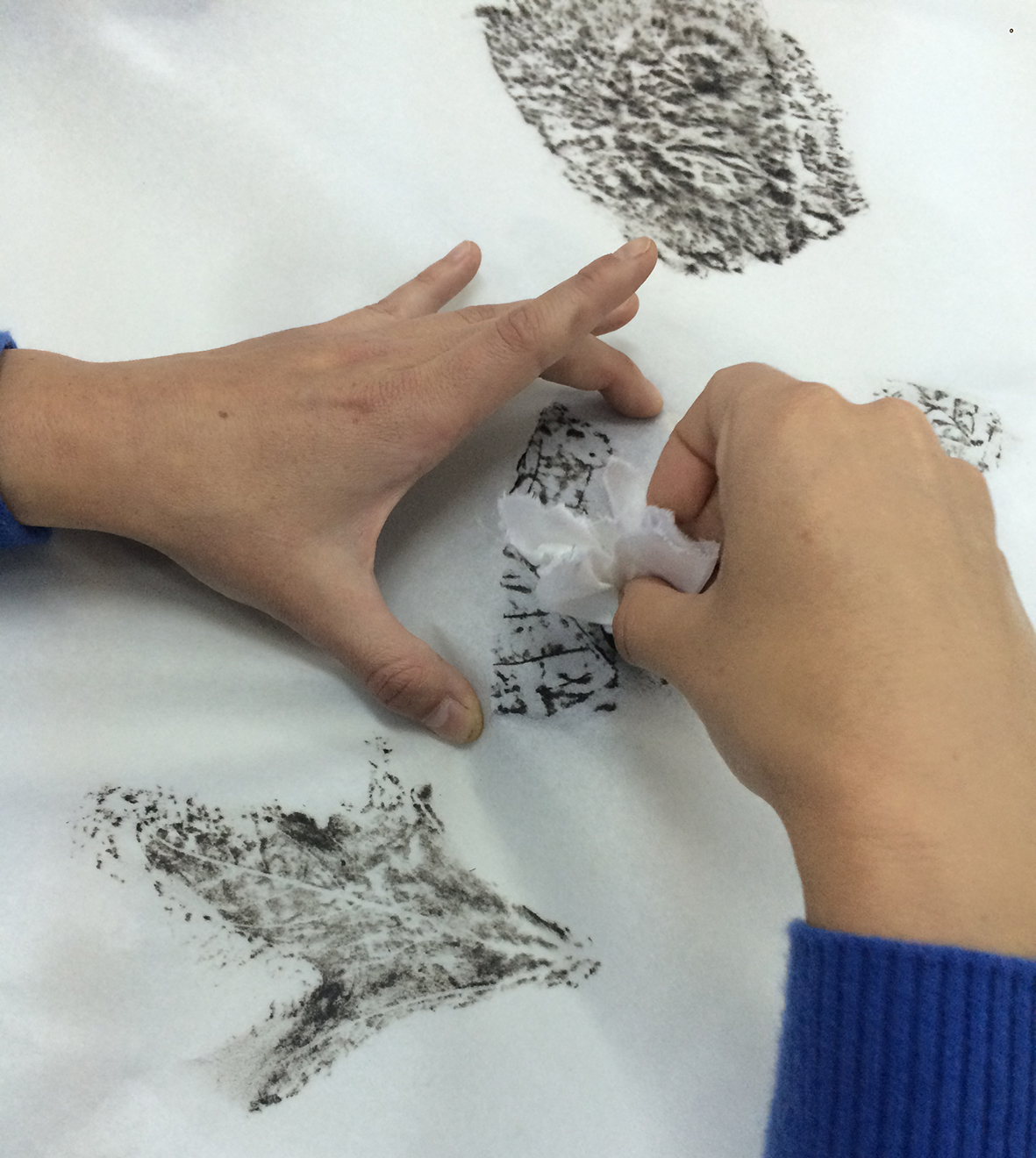
Rubbing in process
Most of the rubbings for the piece were made in the Ceará Cariri Region in northeastern part of Brazil, an important site with the largest Lagerstätte of the Cretaceous Period in Brazil. A combination of erosion and tectonic plate movement has brought a diverse crosssection of the area’s geological history relatively to the surface, allowing it to be studied by paleontologists and geologists. Fossilized species for a large part of the Animalia Kingdom of the phylogenetic tree structure could be found there. I was guided and advised by paleontologists Juliana Manso Sayão, Renan Alfredo Machado Bantim, Flaviana Jorge Lima and Antônio Alamo Feitosa Saraiva. Some ink rubbings were made on-site, and geological elements were also included in the drawings, such as this limestone strata at the Pedra Cariri Geosite. Limestone from the Araripe Basin has been extracted and used in Brazilian civil construction since the nineteenth century.
Some ink rubbings were made on-site, and geological elements were also included in the drawings, such as this limestone strata at the Pedra Cariri Geosite. Limestone from the Araripe Basin has been extracted and used in Brazilian civil construction since the nineteenth century. The natural limestone is arranged in thin layers of sediments, deposited by calms waters over 112 million years ago, capturing and preserving an abundant biodiversity. In recent years, a huge effort has been made to collect the fossils—including those from vertebrates, invertebrates, insects and plants—extracted from limestone quarries. These kinds of fossils are known as Lagerstätte, a sedimentary deposit that exhibits extraordinary fossils with exceptional preservation—sometimes including preserved soft tissues.
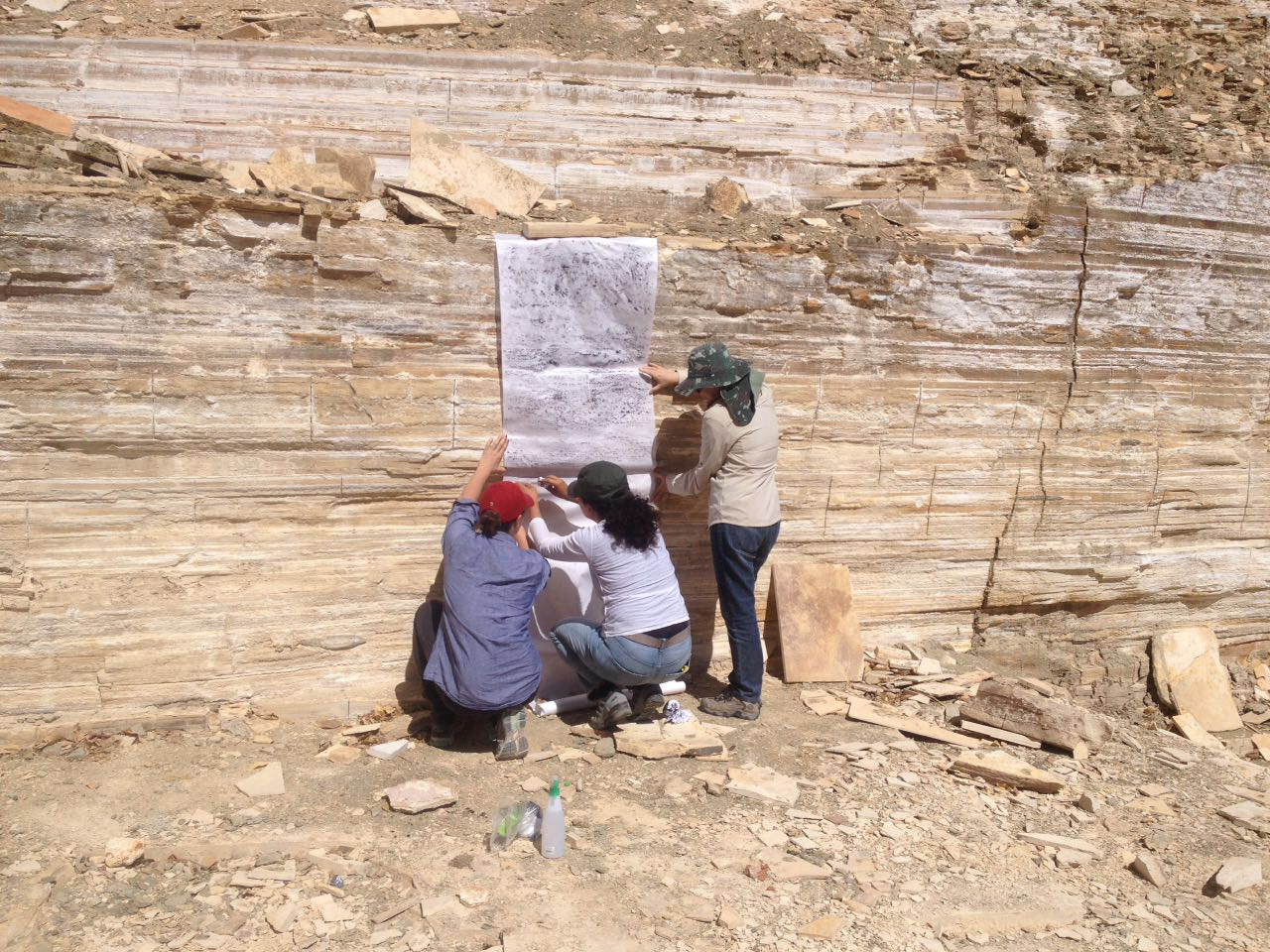
Rubbing in process at the Parque dos Pterossauros

Rubbing in process at the Cariri Regional University Palaeontology Museum
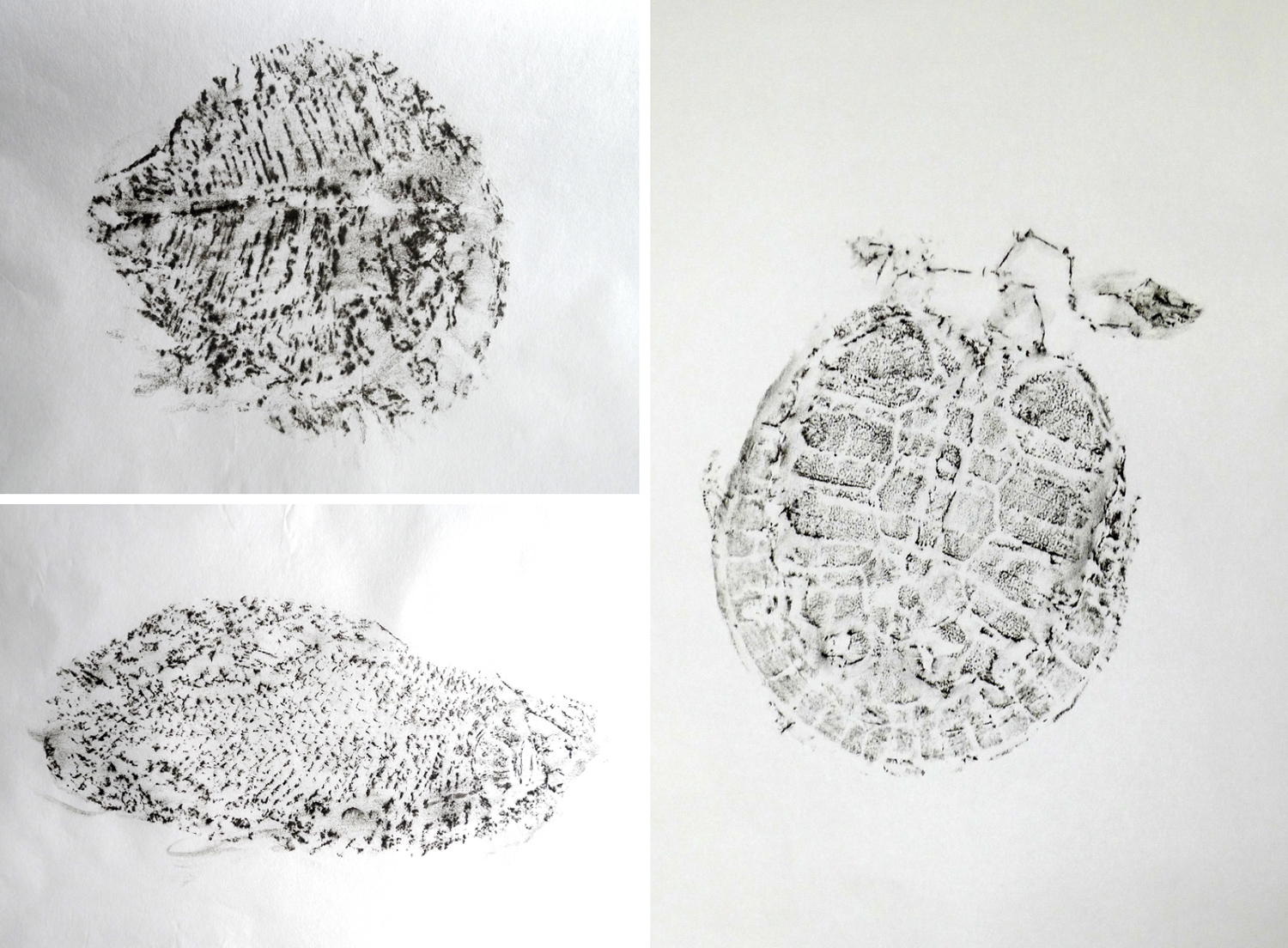
Left: Early Cretaceous 100-145 million years old Chapada do Araipe, Brasil
Right: Tartaruga Pelomeduzidae (Cope 1868)
Rubbing of fossils on Japanese paper, Sumi ink
Microscopic bacteria such as cyanobacteria created unique structures some dating from 3.7 billion years ago. The university collection carries replicas of the debated Ediacaran fossils (Ediacaran Period, 600 M.A.), organisms that resist conforming to a tree of life; it is not even established if they were animals, with suggestions that they were perhaps lichens, algae, protists known as foraminifera, fungi or microbial colonies, or a hypothetical intermediate between plants and animals.
As research and work proceeded—from Berlin to Crato and finally to São Paulo—some dilemmas emerged: some species never leave fossils behind (such as fungi), many are microscopic (i.e. bacteria, archaea, protozoa), and others evolved too recently to have left many fossils behind (flowering plants). Like in a strategy game, each scientist that assisted the work would help to adapt the map by adjusting the order, adding and removing species to adjust to the fossil collection on hand but would remain within the logic and physical constraints of the phylogenetic tree.
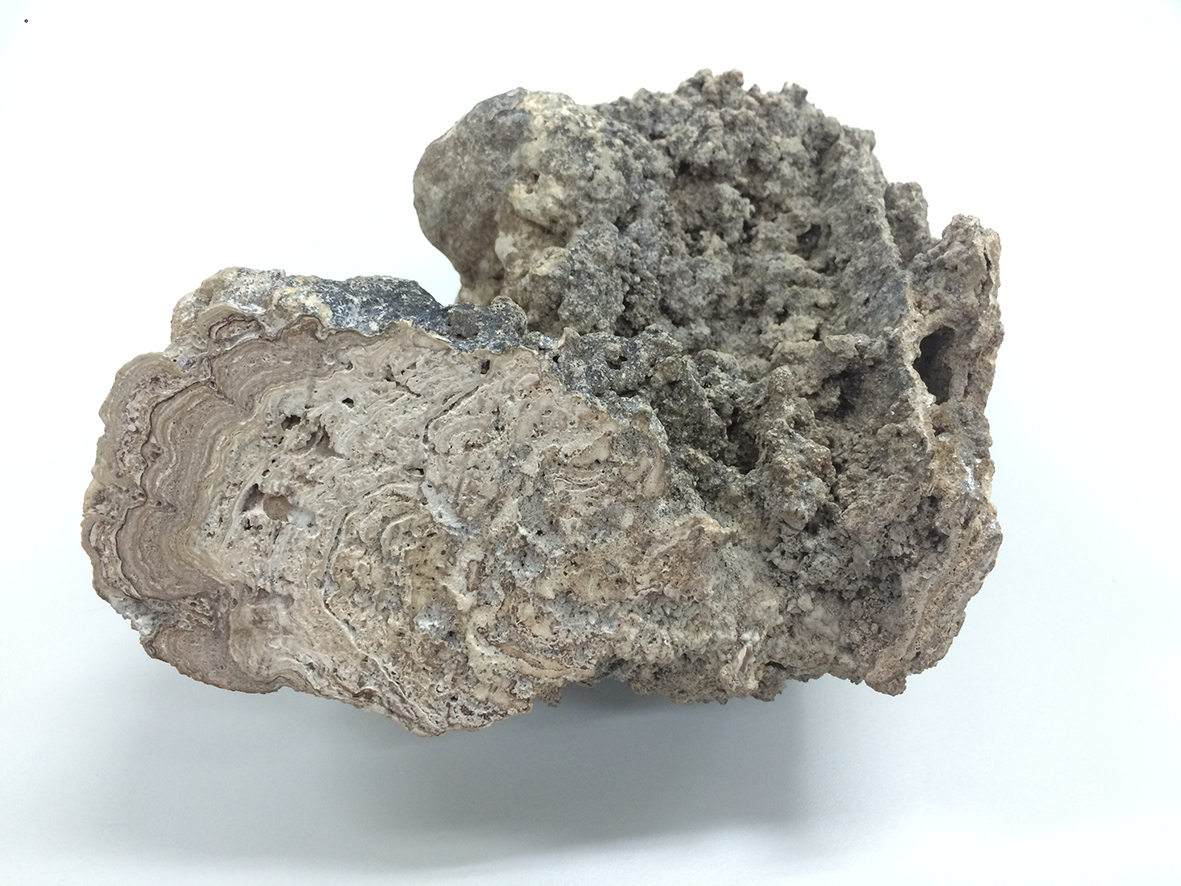
Resin and plaster casts of debated “Ediacaran” or “Vendian” biota fossils. Institute of Geosciences at the University of São Paulo
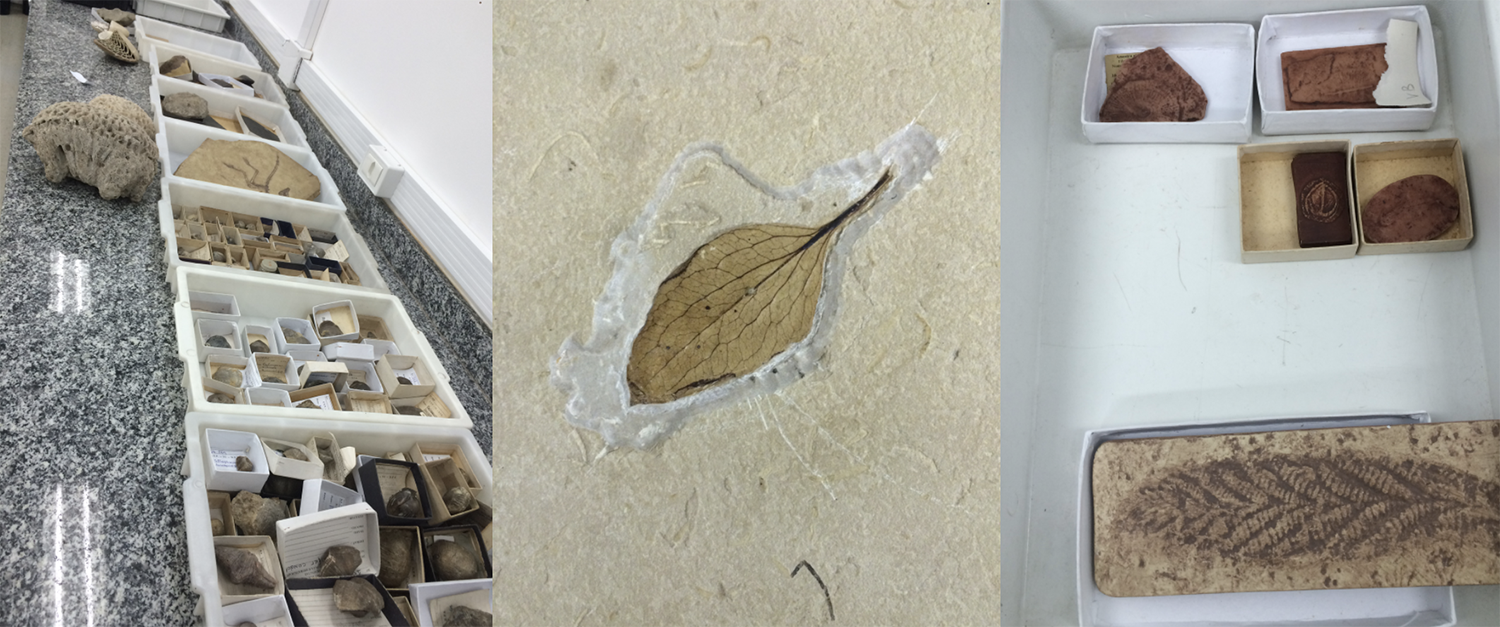
Resin and plaster casts of debated “Ediacaran” or “Vendian” biota fossils. Institute of Geosciences at the University of São Paulo
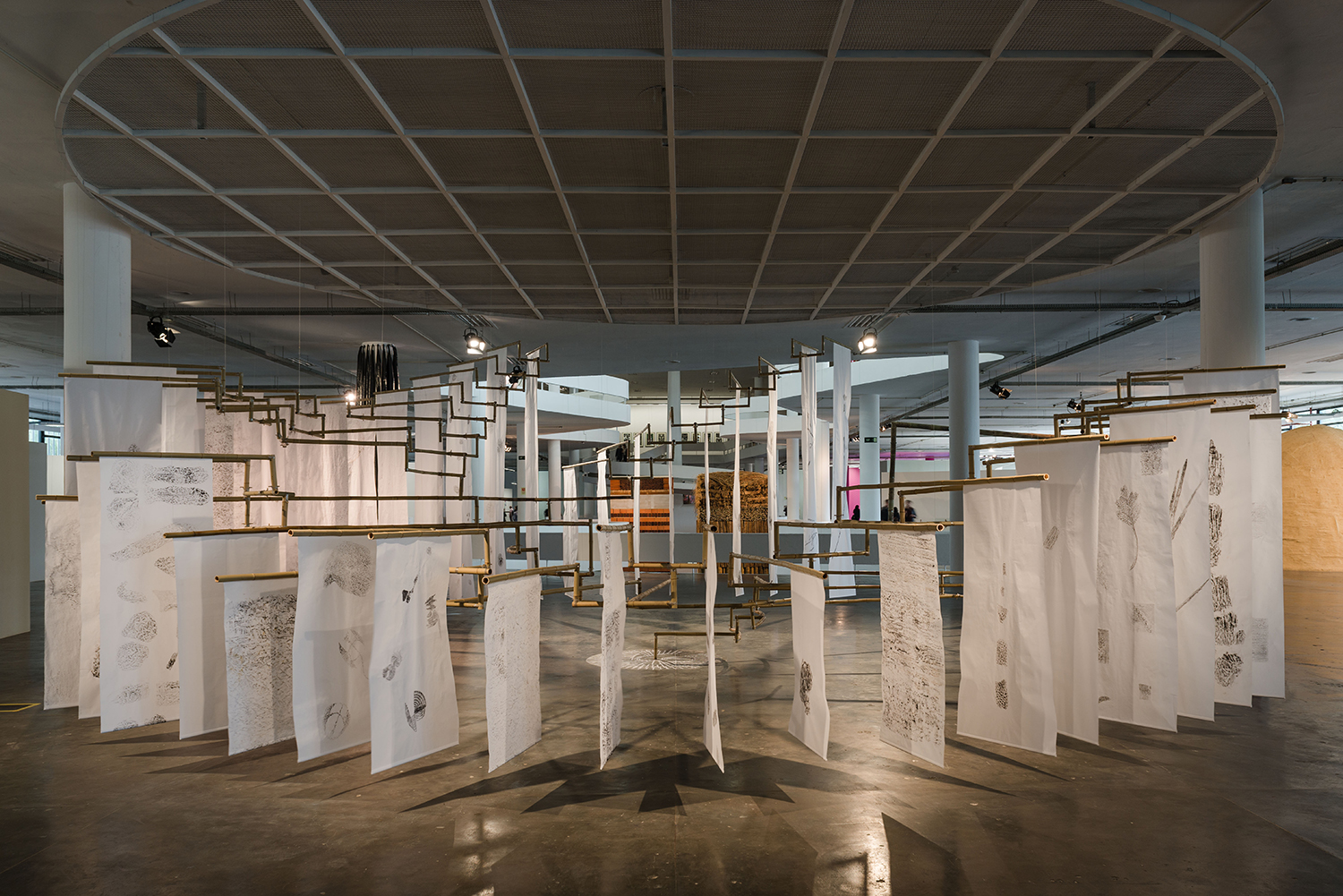
Hypothesis of a Tree, 2015
Bamboo structure, rubbings on Japanese paper, Sumi ink.
Installation view 32nd Bienal de São Paulo, Sao Paulo, 2016.
photo: Leo Eloy / Estúdio Garagem

Detail: Hypothesis of a Tree, 2015
Bamboo structure, rubbings on Japanese paper, Sumi ink.
photo: Leo Eloy / Estúdio Garagem
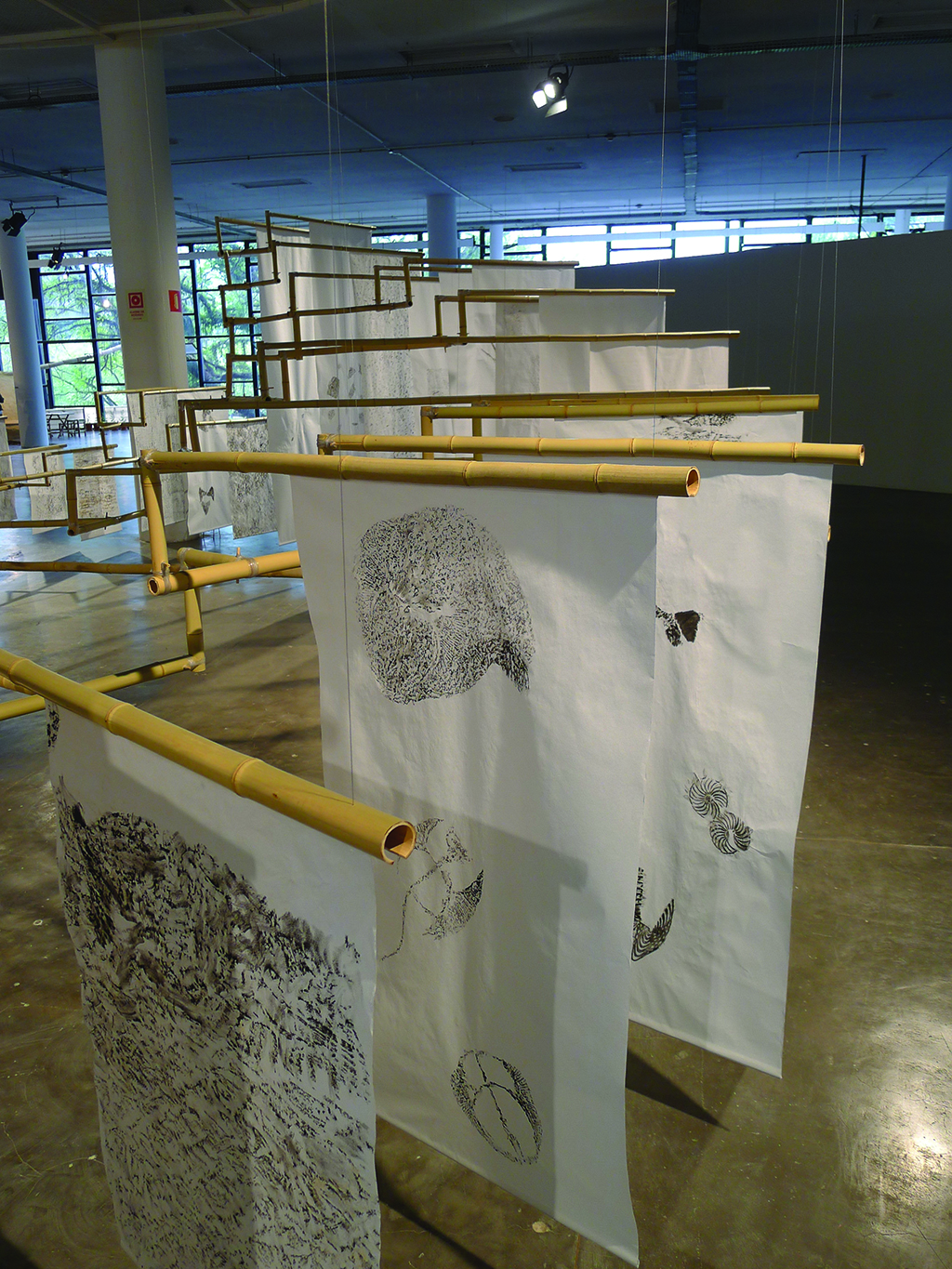
Detail: Hypothesis of a Tree, 2015
Bamboo structure, rubbings on Japanese paper, Sumi ink.
photo: Leo Eloy / Estúdio Garagem
The final work was a spiral bamboo structure, based on a phylogenetic tree, showing the evolutionary relationships among biological species. From the structure hang the series of paper rubbings of fossil sediments from the Crato formation (Chapada do Araipe), the Museum and Institute of Palaeontology from the Carirí Regional University, and the Institute and replica workshop from the Institute of Geosciences at the University of São Paulo, Brazil.

Detail: Hypothesis of a Tree, 2015
Bamboo structure, rubbings on Japanese paper, Sumi ink.
photo: Leo Eloy / Estúdio Garagem

Detail: Hypothesis of a Tree, 2015
Bamboo structure, rubbings on Japanese paper, Sumi ink.
photo: Leo Eloy / Estúdio Garagem
RELATED PUBLICATIONS